Bulletin – February 2002 Statement on Monetary Policy
Download the complete Statement 877KB
The Australian economy has remained resilient in the face of the slowdown in world growth that occurred during 2001. Real GDP increased at an annual rate of 4 per cent over the first three quarters of 2001, and indications to date suggest growth continued at a good pace in the December quarter. The relatively strong performance of the Australian economy during the current global downturn has reflected, at least in part, an absence of the structural imbalances which have been associated with cyclical downturns in the Australian economy in the past. For example, with the level of business investment quite moderate, there has been no accumulation of widespread over-capacity such as had occurred in some previous cycles. In addition, wage and inflationary pressures have remained contained, which allowed domestic policy settings to be eased last year to support growth in the face of the contractionary effects of the world recession.
Nevertheless, there are clear signs that the world growth slowdown is affecting the Australian economy. After a period where the external sector had made a substantial contribution to output growth, it reduced growth in the second half of 2001, as demand fell in most of Australia's major export markets. The synchronised nature of the current international slowdown has limited the scope for Australia's exporters to divert sales to other markets, although the low level of the exchange rate has continued to help exporters. A factor assisting the Australian economy over recent years has been the favourable trend in the terms of trade. Australia's commodity prices have increased in foreign-currency terms and, even more so, in terms of Australian dollars, since their trough in 1999, providing a significant boost to export incomes over much of that period.
While the world recession has reduced the volume of exports, domestic demand has strengthened. Household spending has continued to grow at a solid pace, despite a subdued labour market, and consumer confidence in recent months has been high. Further increases in household wealth, together with moderate increases in incomes and the boost to spending power from lower petrol prices and interest rates, have underpinned the growth in consumption. As long as the labour market remains relatively weak, however, there is some risk that consumption growth may moderate in the period ahead.
The rebound in the housing sector provided a boost to growth over the second half of 2001, although even abstracting from the contribution of that sector, the economy has been expanding at a solid pace. Forward indicators of housing activity indicate that this boost to growth is likely to fade in the second half of 2002 and activity in the sector may even decline, though the size of any downturn should be significantly smaller than that experienced in the second half of 2000.
There is some prospect that the effect of any slowdown in the housing sector on domestic demand will be counterbalanced by a pick-up in business investment. Activity in the non-residential construction sector is clearly picking up after remaining subdued for the past couple of years, boosted by a number of large infrastructure projects. Surveys of business confidence suggest that it has rebounded from its post-September lows, and indicators of investment intentions are pointing to a pick-up in investment in some sectors, most notably mining. Should the international outlook improve in coming months, a more broad-based pick-up in investment and hiring intentions may become evident.
Over the past few months, there have been a number of indications of a more positive outlook for the world economy. This is particularly the case in the United States, but there are also signs of recovery in a number of east Asian countries. The US national accounts reported marginally positive growth in the December quarter, a stronger result than most had expected. Consumer and business sentiment have improved from their post-September lows and businesses have been able to clear at least some of their excess inventories. There has also been some recovery in sentiment evident in Europe. The information and technology sector, which had been an important contributing factor in the initial stages of the global downturn, is showing signs of stabilisation with ITC equipment spending edging slightly higher in the US and a pick-up in production in some east Asian countries.
Against this background, the downgrades to international growth forecasts that had continued throughout 2001 appear to have ceased, and most observers expect a recovery in the global economy to get under way during the course of 2002, underpinned by the expansionary policy settings now in place. Nevertheless, at this stage it appears that such a recovery is likely to be modest, and would still imply a substantial degree of excess capacity for some time ahead. While the US economy appears to have stabilised, existing imbalances may constrain the strength of its recovery for some time. The most significant risk to a sustained recovery in the world economy may lie with Japan, where there is some possibility that the economy could deteriorate sharply in 2002. Continued weakness in the Japanese economy may limit the recovery in other Asian countries.
The improving world outlook has been reflected in a number of ways in financial markets: expectations of further monetary easing have been scaled back sharply in most countries; longer-term interest rates have risen; credit spreads on corporate debt have narrowed again; and share markets have recovered strongly from their post-September lows. These features have been common to all major countries, with the exception of Japan where markets remain gloomy about the economic outlook. Conditions in emerging markets have also generally improved recently; the default by Argentina on its sovereign debt and its subsequent devaluation did not spill over into adverse consequences for other markets.
The improvement in economic prospects has meant that recent high-profile corporate collapses in the US have had a limited impact on markets. Nonetheless, there is a feeling of wariness in markets about the possibility of more negative surprises, which has led to falls in share prices. There has also been a lot of questioning of the adequacy of accounting and corporate governance arrangements.
In Australia, signs of increased confidence in financial markets have, in many respects, been more pronounced than in other countries because of the continuing relatively good growth of the Australian economy. This relative economic strength has been reflected most clearly in the performance of the domestic share market, which remains close to its peak; markets in other countries are generally down 20–30 per cent from their early 2000 levels. There has been a resumption of portfolio equity flows into Australia from abroad, after a period in 2000 when such investment had largely ceased. Together with increased inflows into Australian dollar bonds (particularly by Japanese retail investors), this has helped to steady the exchange rate over most of the past year, after the sharp fall that occurred during 2000 and early 2001.
Underlying inflation in the December quarter was broadly in line with the outlook presented in the November Statement, which had indicated that inflation would exceed the target for a temporary period before declining to around the middle of the target range. In the quarter, the CPI was boosted by sharp increases in the prices of a number of items, particularly some food products, which are likely to be relatively transient. Working in the other direction, the CPI was reduced by declining petrol prices. Both the CPI and underlying measures show inflation on a gradual upward trend over the past few years, with the underlying measures picking up from a little below 2 per cent in 1999 to around 3¼ per cent currently. This pick-up has reflected a rebuilding of margins in response to the depreciation of the exchange rate and other cost pressures, including the rise in petrol prices that occurred during 2000.
These factors are unlikely to result in an inflation rate which stays above the target for an unacceptable time. The exchange rate has been relatively stable since early 2001 in trade-weighted terms. Hence, while the earlier depreciation has clearly placed upward pressure on prices in the tradables sector, the effect on the rate of inflation can be expected to diminish over time. The growth of wage costs remains moderate, and productivity growth appears to have returned to the strong pace evident over the second half of the 1990s, after a cyclical slowdown in 2000. These trends point to growth of unit labour costs at a rate consistent with attainment of the inflation target in the medium term. Moreover, with inflation expectations firmly anchored, and labour market conditions relatively subdued at present, there is little likelihood that wage pressures will increase in the period ahead.
Of a more immediate nature, the fall in petrol prices over the past year has eased cost pressures on business, although some cost pressures still remain including rising insurance premiums and electricity charges. Indicators of upstream price pressures have also been suggesting slower overall growth in input costs in recent quarters. Given all these factors, the Bank's assessment is that inflation is currently at or near its peak and that it will decline to around the middle of the target over the year ahead, both in terms of the CPI and in underlying terms. The assessment as to underlying inflation is broadly the same as that presented in the November Statement, although the risks around this outlook now appear more evenly balanced, rather than being weighted to the downside.
The stance of monetary policy was progressively eased over the course of 2001 as the extent of the slowdown in world growth became apparent. This easing continued in December, when the cash rate was reduced to its lowest level in almost 30 years, bringing the cumulative reduction in the cash rate to 200 basis points. As a result of these reductions over the past year, policy settings are now clearly expansionary and supporting growth in the domestic economy.
At its February meeting, in view of the recent changes in the balance of risks for the global economy and for domestic inflation, the Board decided to leave the cash rate unchanged. While the global economy remains weak at present, there have been a number of more promising signs in recent months. In the final months of 2001, the main risks to the world outlook were clearly on the downside, with consequent risks for the Australian economy. In recent months these risks appear to have lessened, as confidence around the world has improved and signs of stabilisation have emerged. Hence, while a significant global recovery in 2002 is not yet assured, it does appear more likely than was the case a few months ago. Downside risks to the global economy include the fragility of the Japanese economy and the possibility that more adverse news could emerge in coming months about the US corporate sector. On the other hand, the stimulatory policy settings now in place in the major countries may engender a stronger recovery than currently envisaged. All of this will have important implications for Australia, since a solid global recovery would clearly make it easier for the Australian economy to maintain its recent strength. As always, the Bank will continue to assess these medium-term developments with a view to promoting sustainable growth consistent with the inflation target.
International Economic Developments
The world economy slowed through 2001, with growth for the year expected to be about half the pace recorded in 2000 (Graph 1). GDP is likely to have contracted in Japan, the US, Germany and several Asian countries in the second half of the year. While the terrorist attacks in the US complicated the analysis of much of the economic data in the latter part of the year, in recent months signs of improving conditions have emerged in the US and some Asian economies, though prospects remain bleak in Japan. There are some indications that demand is stabilising in the information technology and communications (ITC) sector, which has been a major source of weakness in the current downturn, with semiconductor sales and ITC production in parts of Asia picking up recently.
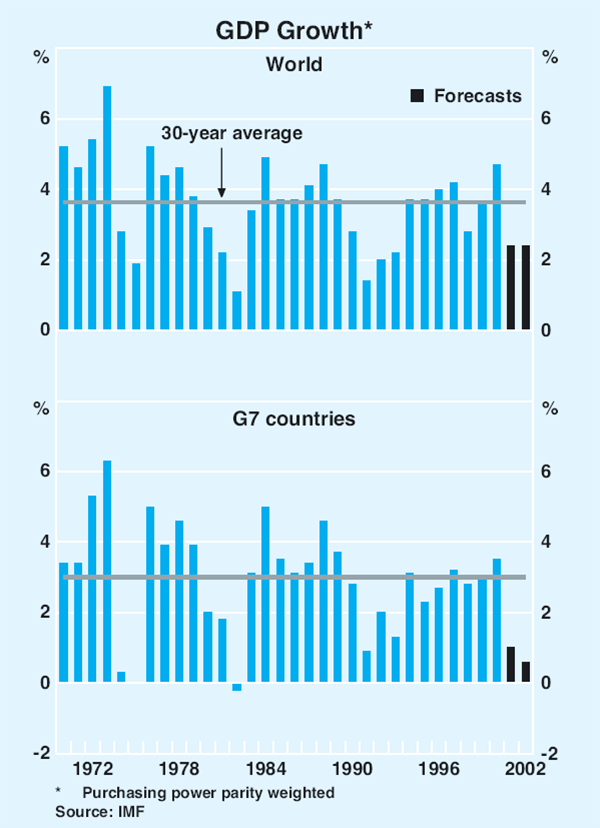
The IMF forecasts released in December project only a gradual recovery in 2002 with world growth forecast to remain at just under 2½ per cent, although they do imply a noticeable pick-up in growth over the course of 2002. If realised, these forecasts would result in the weakest two consecutive years of growth since the mid 1970s for the G7 countries and for Australia's major trading partners.
The widespread easing of monetary policy and, in a number of countries, fiscal policy in 2001 should support growth in coming months, and lower oil prices will be beneficial for growth in the industrialised countries and much of Asia. There is some chance that the stimulus from these sources will result in higher-than-expected growth, but there remain significant risks to the world outlook on the downside, although less so than in recent months. Financial imbalances and possibly excessive investment continue to pose a threat to the speed of the US recovery, and significant risks surround the outlook for Japan, with the possibility of adverse developments there jeopardising recovery in the rest of Asia.
The Americas
The US economy contracted over the second half of 2001, with output in the December quarter 0.3 per cent lower than the June quarter level (Graph 2). In the December quarter, strong growth in consumption and public spending was almost fully offset by another large rundown in inventories and a further decline in business investment (Table 1). Business investment has contracted for four consecutive quarters to be 9 per cent lower over 2001, with expenditure on equipment and buildings and structures declining at a similar rate.
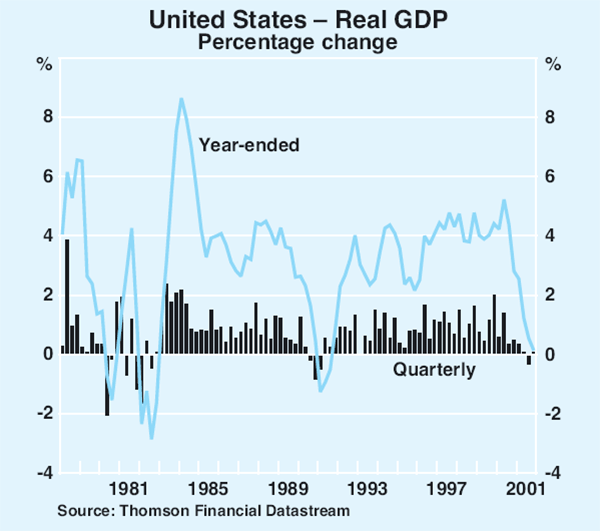
| September quarter 2001 |
December quarter 2001 |
Year to: | ||
|---|---|---|---|---|
| December 2000 | December 2001 | |||
| Private consumption | 0.2 | 1.3 | 4.2 | 3.0 |
| Residential investment | 0.6 | −1.7 | −1.2 | 2.4 |
| Business investment | −2.2 | −3.4 | 8.9 | −9.2 |
| Public demand | 0.1 | 2.2 | 1.2 | 4.9 |
| Change in inventories(a) | −0.3 | −0.6 | −0.6 | −1.8 |
| Net exports(a) | 0.0 | −0.2 | −0.9 | −0.1 |
| – Exports | −5.1 | −3.3 | 7.0 | −11.3 |
| – Imports | −3.4 | −0.9 | 11.3 | −7.5 |
| GDP | −0.3 | 0.1 | 2.8 | 0.1 |
|
(a) Contribution to GDP growth Source: Thomson Financial Datastream |
||||
Private consumption held up reasonably well in 2001, as continued robust growth in wages and the boost to spending power from home equity accessed through mortgage refinancing offset the effects of the deterioration in the labour market. In the December quarter, it received an additional boost from strong growth in motor vehicle sales in response to zero-interest financing provided to purchasers by vehicle manufacturers. Abstracting from motor vehicle sales, household spending still increased by 0.4 per cent in the quarter. The unemployment rate reached a six-year high of 5.8 per cent late in 2001 (Graph 3) and claims for unemployment benefits and the level of job advertisements suggest little improvement in the near term, although these indicators appear to have stabilised recently.
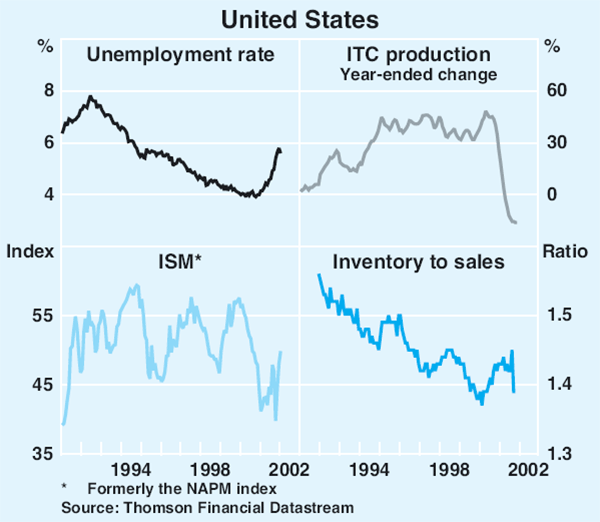
Strong growth in sales of motor vehicles helped to reduce inventory levels in that sector and there are also indications that the inventory correction may be nearing its end in other areas, particularly in ITC inventories, which have declined to levels last seen in 1995. ITC shipments have also stabilised and new orders for ITC equipment have recorded three consecutive months of increase. These developments contributed to an improvement in the Institute of Supply Management (ISM, formerly the National Association of Purchasing Managers (NAPM)) measure of manufacturing sentiment. Nevertheless, manufacturing production continued to decline through the December quarter, although at a slower rate than earlier in the year.
Lower energy prices have underpinned a reduction in consumer price inflation to 1½ per cent over the year to December (Graph 4). However, the core measure of inflation has remained around 2¾ per cent as rises in services prices – particularly for medical care, transport and housing – offset declining goods prices. The weakening in the labour market has not yet caused any significant decline in wages growth, which remained around 4 per cent over the year to December.
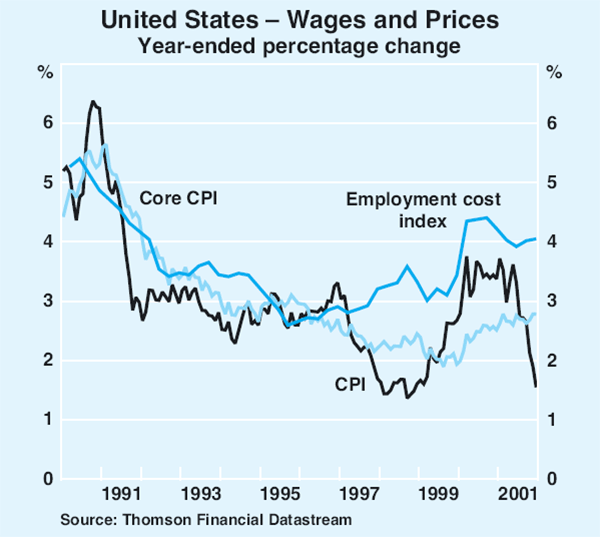
In response to the economic softness and the continuing downside risks to the US outlook, the US Federal Reserve eased monetary policy by 25 basis points in December, bringing the cumulative easing in this interest-rate cycle to 475 basis points. However, in response to signs of a turning point in the economy and in light of the already stimulatory stance of monetary policy, the Fed left rates unchanged at its January meeting. Fiscal policy also provided some stimulus in the second half of 2001, in the form of income tax cuts, emergency relief following the terrorist attacks and expenditure related to the war on terrorism.
Continuing economic and political turmoil in Argentina culminated with the government defaulting on its debt and the abandonment of the decade-long currency board. Subsequently the peso has depreciated sharply. (Further details are provided in the ‘International and Foreign Exchange Markets’ chapter.) Other economies in Latin America have suffered from the slowdown in world growth, particularly Mexico, but to date, there is little evidence of contagion from the events in Argentina.
Asia-Pacific
Japan
The Japanese economy contracted again in the September quarter and indications are that the economy remained weak in the December quarter (Graph 5). Over the year to September, Japanese GDP fell by ½ per cent, due largely to a decline in exports of nearly 10 per cent and a decrease in consumption.
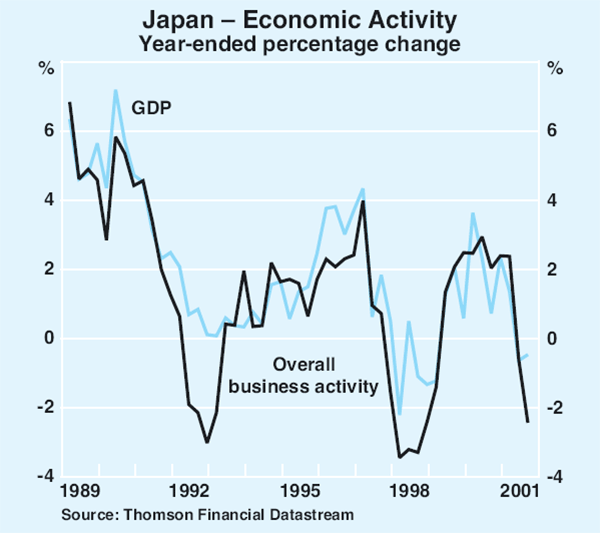
Further falls in manufacturing production contributed to another shift down in the overall business activity indicator in the latter part of 2001. The weakness in the manufacturing sector has been broad-based, with ITC manufacturing output and export volumes both over 30 per cent below late-2000 levels, and non-ITC manufacturing output is well below Asian-crisis levels. The contraction in manufacturing output through the second half of 2001 has been reflected in weak investment and employment outcomes (Table 2). In the rest of the economy, sentiment, profits and orders of machinery have been more resilient, but employment in December was still no higher than a year earlier.
| Annualised growth Percentage change, year to December | ||
|---|---|---|
| Average 1997–2000 | 2001 | |
| Employment | −0.1 | −1.2 |
| – Manufacturing (20 per cent of total) | −2.3 | −5.6 |
| – Non-manufacturing (80 per cent of total) | 0.6 | 0.0 |
| Unemployment rate (per cent) | 4.2 | 5.6 |
|
Source: Thomson Financial Datastream |
||
The deterioration in the labour market has seen the unemployment rate reach a record high of 5.6 per cent in December. This, together with falling wages, has contributed to weakness in incomes and hence consumption. Consumer prices have continued to fall, with the core measure of deflation around ¾ per cent over the year to December 2001.
In line with its pledge to limit new bond issuance to 30 trillion yen, the government sees little or no scope for further fiscal stimulus. Initial budget plans for fiscal year 2002 suggest a reduction in general spending of 2¼ per cent. With no latitude for official interest rates to be reduced, the Bank of Japan has responded to the deteriorating circumstances by implementing measures designed to boost the level of settlement funds held by the banking system, including the purchase of Japanese government bonds.
Non-Japan Asia
The downturn in world growth through 2001 has had a marked effect on growth in non-Japan Asia, although the impact across countries has been far from uniform (Table 3). Most countries have experienced large declines in exports, greater than that which occurred during the Asian crisis, with the largest falls occurring in those countries with a high concentration of semiconductors and other ITC products, notably Singapore, Taiwan, Hong Kong and Malaysia. These four countries have also experienced declines in domestic demand, reflecting weak business investment and rising unemployment. Korea is an exception; despite being a large ITC producer, it experienced robust growth in the latter part of 2001 reflecting a pick-up in public spending and strong growth in consumption. Relatively robust rates of GDP growth were also recorded in China, Indonesia and the Philippines in 2001.
| GDP | Exports(a) | Industrial production(a) |
|||
|---|---|---|---|---|---|
| Latest quarter | Year to latest | Six months to latest month | |||
| Hong Kong | 0.4 | −0.7 | −0.4 | −7.1 | |
| Indonesia | 2.4 | 3.5 | −16.4 | na | |
| Korea | 1.2 | 1.6 | 10.0 | 4.5 | |
| Malaysia | −0.6 | −1.3 | −4.7 | 3.6 | |
| Philippines | 1.0 | 3.8 | 3.0 | 2.3 | |
| Singapore | −2.9 | −5.6 | −8.8 | −3.3 | |
| Taiwan | −1.3 | −4.2 | −2.9 | −0.5 | |
| Thailand | 0.0 | 1.4 | −9.9 | 3.0 | |
| China | na | 7.3(b) | −0.8 | 7.1 | |
| Non-Japan Asia(c) | 0.3 | −0.1 | −7.2 | 2.6 | |
|
(a) Seasonally adjusted by RBA Source: CEIC |
|||||
The manufacturing sector in non-Japan Asia has borne the brunt of the slowdown, with output declining by a similar amount to that experienced during the Asian crisis. There was a small increase in manufacturing output in the September quarter, with industrial production data indicating further gains in the December quarter in the major ITC-producing countries, mostly driven by a pick-up in ITC goods production. In contrast to the Asian crisis, the services sector, while slowing, has continued to grow over the past year, and there has been little change in output in the construction sector which had collapsed during the Asian crisis (Graph 6).
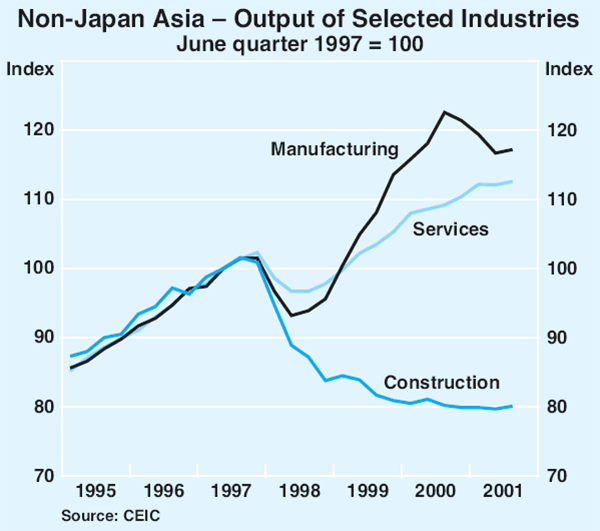
Inflation has declined in most non-Japan Asian economies, due to falling demand and lower oil prices, with China, Hong Kong, Singapore and Taiwan recording price falls in year-ended terms. Reflecting the weakness in economic activity and subdued inflation, monetary policy was eased further in recent months in the Philippines, Taiwan and Thailand.
New Zealand
Following robust growth in the June quarter, GDP grew only marginally in the September quarter to be 2½ per cent higher over the year. The weaker growth reflected a decline in exports, and particularly tourism, which accounts for around 5 per cent of GDP. Consumer spending has remained relatively robust with steady employment growth and wage increases contributing to growth in household incomes. Inflation fell to 1.8 per cent in the December quarter after a period at the upper end of the RBNZ's target band. The RBNZ reduced the official cash rate by a further 50 basis points in November to 4.75 per cent.
Europe
Conditions across the euro area weakened in the second half of 2001, with GDP increasing only slightly in the September quarter, reflecting a slowing in private consumption growth and a rundown in inventories. Output contracted in Germany in the September quarter – mostly due to a decline in investment which was around 5 per cent lower over the year – whereas GDP increased by around ½ per cent in France. Activity appears to have remained subdued in the December quarter, with manufacturing production falling further, particularly in Germany and Italy.
The labour market has weakened across the euro area since the middle of the year, with employment growth slowing in all major countries and unemployment rates plateauing after falling over the first part of 2001. Lower oil prices resulted in inflation falling from 3½ per cent over the year to May to 2½ per cent over the year to January (Graph 7). However, the core measure of inflation drifted higher to be 2.3 per cent over the year to December.
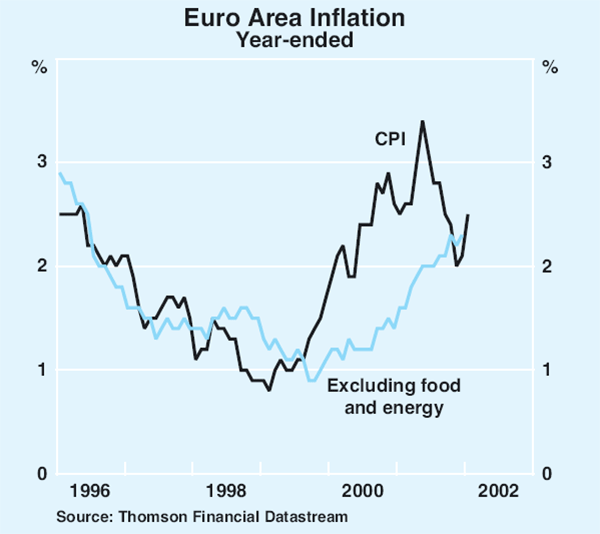
Growth in the UK continued to be stronger than in the euro area over the second half of 2001, but there has been a marked dichotomy between the manufacturing sector and the rest of the economy. Manufacturing output was around 5 per cent lower in the December quarter than a year earlier, while the service sector has expanded by around 3½ per cent over the same period. Inflationary pressures have also eased in the UK, with consumer prices excluding mortgage interest payments increasing by 1.9 per cent over the year to December.
International and Foreign Exchange Markets
Short-term interest rates
While there have been some further reductions in official interest rates in developed countries in recent months, the cycle of global monetary easing that began in January 2001 could be nearing an end. Measured in terms of the number of central banks changing policy, the easing process gathered momentum through the first five months of 2001, paused around the middle of the year, and then resumed. Central bank activity peaked in September when all major central banks eased monetary policy, but it had already picked up in August, ahead of the terrorist attacks, as the outlook for economic activity in many countries had already started to deteriorate by then (Table 4). By December, the number of central banks easing had slowed to three, while in January 2002, only one central bank eased.
| Jan 2001 | 3 |
|---|---|
| Feb 2001 | 4 |
| Mar 2001 | 5 |
| Apr 2001 | 5 |
| May 2001 | 6 |
| Jun 2001 | 1 |
| Jul 2001 | 2 |
| Aug 2001 | 5 |
| Sep 2001 | 10 |
| Oct 2001 | 5 |
| Nov 2001 | 6 |
| Dec 2001 | 3 |
| Jan 2002 | 1 |
| (a) Countries included: US, Japan, Canada, Australia, NZ, UK, euro area, Sweden, Denmark, Switzerland | |
Perhaps most significantly, the US Fed left interest rates unchanged at its end-January meeting after having cut interest rates at every policy meeting in 2001, as well as on three occasions between meetings. In total, the target rate for Fed funds has been reduced by 475 basis points, to 1.75 per cent, its lowest level since the early 1960s and 125 basis points below the low point seen in the early-1990s recession (Graph 8). In real terms, the Fed Funds rate is near zero (using the core personal consumption expenditure deflator) or negative (using the core CPI as a deflator). On both measures, it is close to the lows reached in the early 1990s.
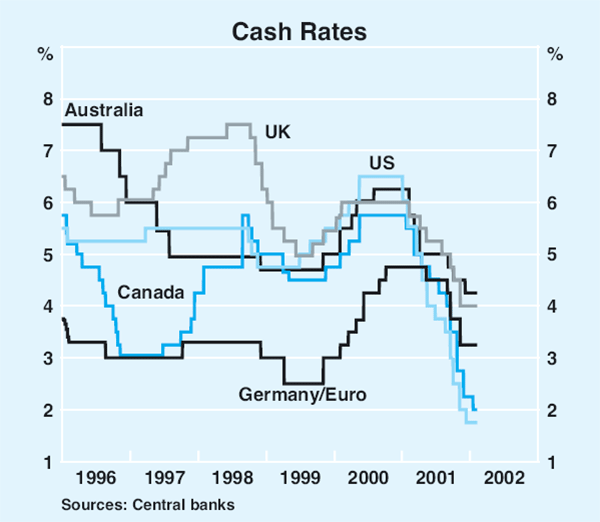
With the current level of the Fed funds rate unusually low, and financial markets becoming more optimistic about the US economic outlook, markets have turned their focus to the question of when a tightening in US policy might occur. The futures market is pricing-in the likelihood that monetary tightening will begin around the middle of this year.
After the Fed, the largest cumulative cut since the start of 2001 has been by the Bank of Canada, which has cut its overnight cash rate by 375 basis points to 2.0 per cent. After that came the Bank of England and the RBA, both of which cut rates by 200 basis points during 2001, followed by New Zealand and Switzerland, which cut rates by 175 points, and the ECB, which cut rates by 150 points (Table 5).
| 2001 | 2002 | Cumulative changes since Jan 2001 |
Current level Per cent |
||
|---|---|---|---|---|---|
| Jan to Jun | Jul to Dec | Jan | |||
| US | −275 | −200 | −475 | 1.75 | |
| Canada | −125 | −225 | −25 | −375 | 2.00 |
| UK | −75 | −125 | −200 | 4.00 | |
| Australia | −125 | −75 | −200 | 4.25 | |
| NZ | −75 | −100 | −175 | 4.75 | |
| Switzerland | −25 | −150 | −175 | 1.75 | |
| Euro area | −25 | −125 | −150 | 3.25 | |
| Sweden | −25 | −25 | 3.75 | ||
| Japan | −25 | −25 | 0.00 | ||
The Bank of Japan (BoJ), having earlier reduced rates to zero, continued to direct its monetary policy to boosting banks' reserves. When its reserve-targeting policy was first announced in March 2001, the target was 5 trillion yen, which was around 20 per cent above the reserve holdings over the previous year. Subsequently, the BoJ has several times increased the target, and it now stands at 10–15 trillion yen. The Bank of Japan has in fact pushed reserves above target levels in recent months.
Several other central banks in Asia have eased monetary policy a little further over recent months. Short-term interest rates in Asia (with the exception of Indonesia and the Philippines) are currently in the range of 1 to 5 per cent, whereas a year ago they had been in the range of 3 to 7 per cent. As in the major countries, the current level of interest rates in these countries is very low by historical standards (Graph 9).
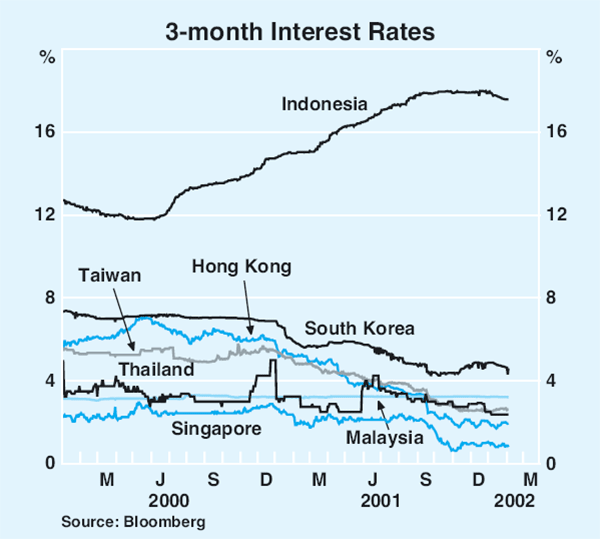
Short-term interest rates in other emerging markets have generally been steady with the exception of Argentina where interest rates have risen sharply as the financial crisis deepened. Short-term interest rates on peso deposits in Argentina fluctuated between 50 and 120 per cent in the months leading up to the formal default on sovereign debt in December. Since then, controls on bank deposits have prevented the normal operation of the banking system.
Long-term interest rates
Long bond yields around the world have increased significantly over recent months. Yields on US government 10-year debt, after falling to as low as 4.2 per cent in early November, have since risen by around 80 basis points to around 5 per cent. This is the same as their level a year earlier, before the Fed started easing, though still 150 points below their peak in early 2000 (Graph 10). The recent increase was mainly due to improved confidence among market participants about an early recovery in the US economy, although it may also have reflected the significant deterioration in the US's fiscal position that also occurred at the same time.
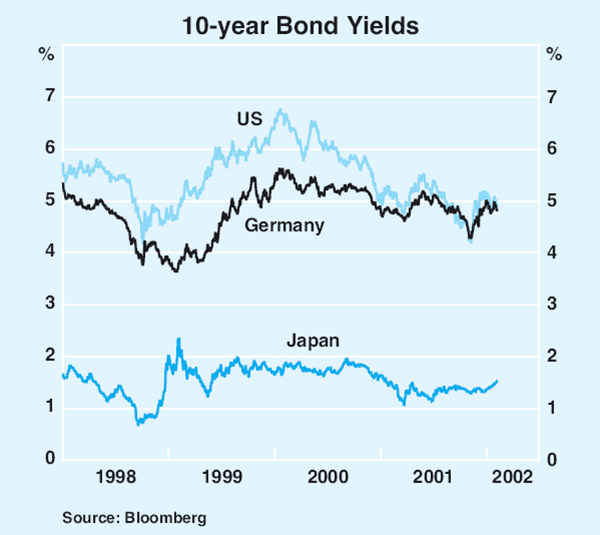
The improved US economic outlook is also evident in the corporate bond market, where credit spreads have moderated noticeably (Graph 11). This has been most apparent in the spread between riskier classes of fixed-income debt and government securities. The spread on ‘junk’ bonds (i.e. yields on non-investment grade securities above US Treasuries) has fallen by 300 basis points since its peak in early November, to the lowest level seen since May 2000.
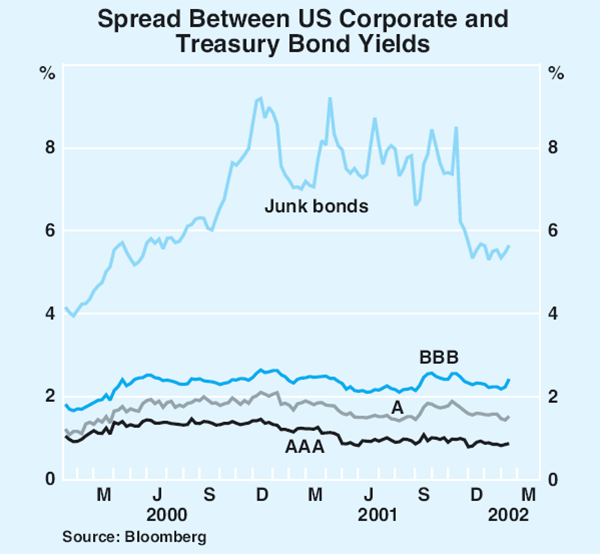
The rise in long-term yields has meant that the yield curve in the US has steepened noticeably; 10-year US government bond yields are now trading at 330 basis points above the Fed funds target, similar to the reading in the early 1990s (Graph 12). This wide gap indicates that monetary conditions in the US are highly accommodative at present.
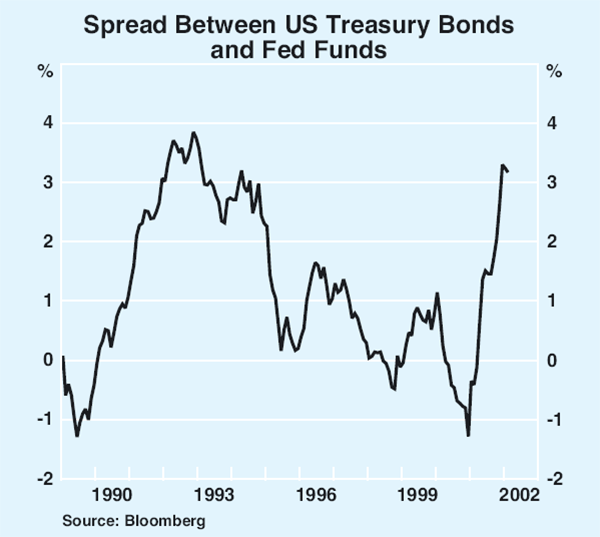
In European bond markets, yields have followed a similar but more subdued pattern than that seen in the US; yields on German 10-year Government bonds have increased by 60 basis points from their November trough, to around 4.85 per cent. This is around the same level as US yields. During the late 1990s the differential in yields between these two countries had averaged about 100 points. The closing of this gap over the past year has mirrored the closing in the growth differential between the US and Germany that had also been apparent in those earlier years.
Yields on Japanese government bonds have been at the top of the band in which they have traded over the past year or so, rising about 1.5 per cent in early February. The rise reflected concerns that ratings agencies would further downgrade Japan's sovereign credit rating.
In the months leading up to the default by Argentina, yields on its sovereign debt increased significantly, with the spread to US Treasuries peaking at over 3,000 basis points, effectively ending the government's ability to rollover maturing debt. There has to-date been very little contagion from these events to other emerging market economies. In fact, despite the troubles in Argentina, spreads between both emerging European and Asian sovereign debt and US Treasuries have narrowed by around 210 basis points and 70 basis points, respectively, since the end of October (Graph 13).
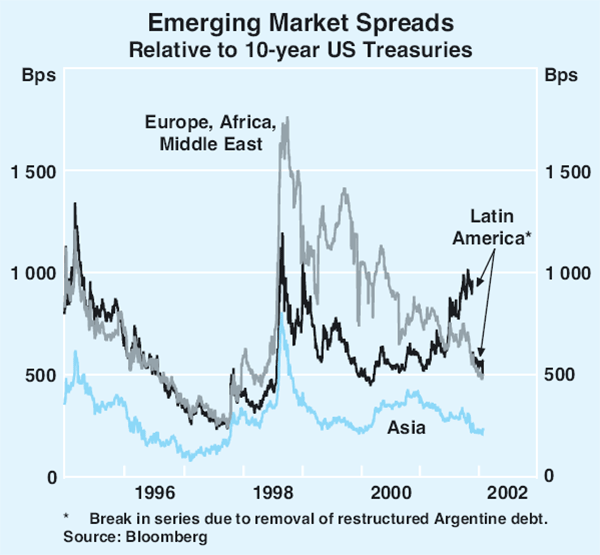
Equity markets
After falling rapidly in the weeks following September 11, equity markets rallied strongly over October, November and December. Initially, this was due to the abatement of the extreme uncertainty that followed the September events, but the rise was sustained by growing expectations that the US economic recovery would start in 2002. This view remains, though concerns that the US company reporting season now underway would produce disappointing earnings, as well as several high profile bankruptcies which have led to some questioning of the earnings measures used by companies, have caused share prices to retrace somewhat in January. In the US, the Wilshire Index, the broadest measure of US share prices (accounting for over 90 per cent of listed companies) is 14 per cent above its 21 September trough, but down 7 per cent from its early January 2002 peak (Graph 14). Likewise the NASDAQ is up 27 per cent from its September trough, but is down 12 from its early January peak. Despite the recent gains, the Wilshire remains 31 per cent below its peak in March 2000, while the NASDAQ remains down 64 per cent.
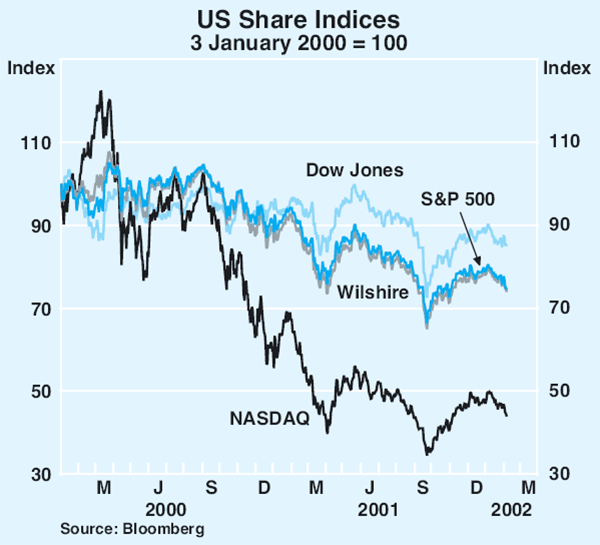
The recent rally in share prices appears to be anticipating a large increase in company earnings in the year ahead. The latest available data on actual earnings, however, still show a very weak picture. Profits announced by S&P 500 companies in aggregate were down by between 33 per cent and 61 per cent in the year to the September quarter, depending on the measure used. Earnings announcements by companies have become difficult to follow because of the range of measures announced by each company (see Box A). The National Income and Product Accounts measure of non-financial corporate profitability, which provides a consistent series, fell 22 per cent in the year to the September quarter (the latest data available). This is the largest one-year fall in at least 50 years. As a share of GDP, non-financial corporate profits fell to 7.5 per cent in the September quarter – the lowest level seen since December 1982 (Graph 15).
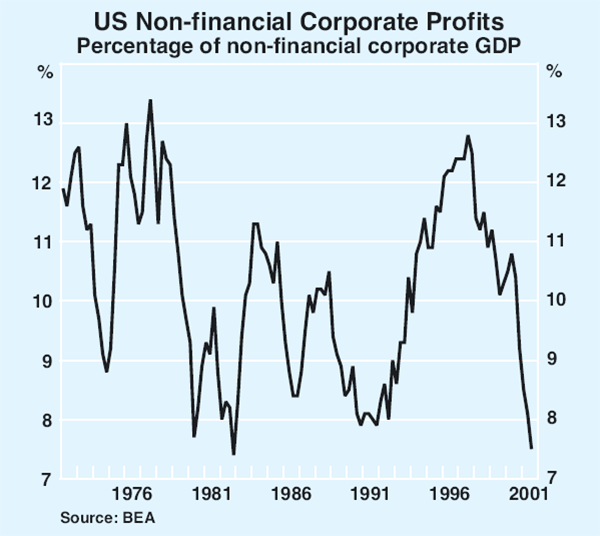
As has usually been the case over recent years, share prices in other countries – with the exception of Japan – have generally followed those in the US. The Euro STOXX index (a broad index of 310 major euro area companies) has risen 22 per cent since its September trough while the FTSE 100 is now 14 per cent up from its trough. However, as in the US, both these markets remain well down from their 2000 peaks – the euro STOXX by 37 per cent and the FTSE 100 by 27 per cent (Table 6).
| Change since 2000 peak |
Change over 2001 |
Change since 21 Sep 2001 trough |
|
|---|---|---|---|
| United States | |||
| – Wilshire | −31 | −12 | 14 |
| – Dow Jones | −18 | −7 | 17 |
| – S&P 500 | −29 | −13 | 12 |
| – NASDAQ | −64 | −21 | 27 |
| Euro area | |||
| – STOXX | −37 | −20 | 22 |
| United Kingdom | |||
| – FTSE | −27 | −16 | 14 |
| Japan | |||
| – Topix | −47 | −20 | −8 |
| Australia | |||
| – ASX 200* | −1 | 7 | 16 |
| Canada | |||
| – TSE 300 | −34 | −14 | 15 |
| * Peak was in 2001 | |||
In Japan, shares have been weak. There has not been the strong recovery from the September trough seen in other countries, with the Topix Index continuing to fall over recent months, touching levels not seen since 1985. The very weak state of the economy and investor concerns about the health of the Japanese financial system have been the reasons for this weakness in share prices. Japanese share prices are now only around one-third of their peak level in 1990.
In aggregate, equity prices in emerging Asia have appreciated strongly over recent months, and are now 29 per cent higher than their late-September trough (Graph 16). Markets are hoping that the expected recovery in the US economy will see the Asian economies also recover over the coming year.
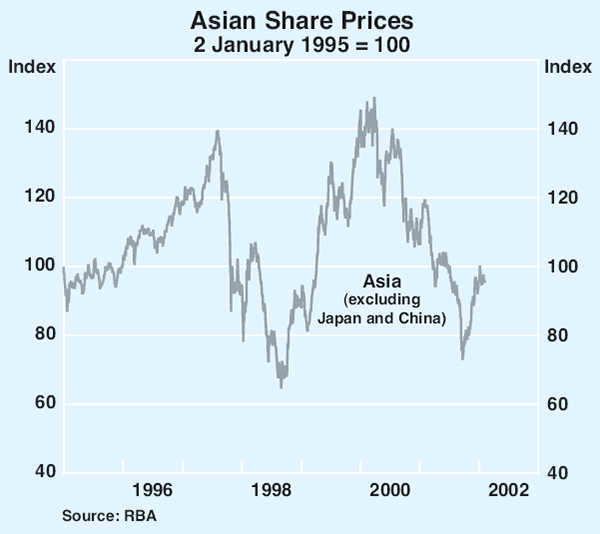
Exchange rates
The increased optimism that the US will lead the world out of recession has given a boost to the US dollar over the past few months. The trade-weighted value of the US dollar has appreciated by 4 per cent over the past three months, and touched a new 15-year high in January (Graph 17). The rise of the US dollar has been broadly based, with the unit up against all major currencies since the end of October. The most significant gains have been against the Japanese yen, against which it has risen 9 per cent since the end of October. The yen has been very weak in its own right over this period, falling significantly against all the major currencies as a result of the continued deterioration of the Japanese economy.

Reflecting the strength of the US dollar, the exchange rate of the euro against the dollar has again fallen in recent months, and is now towards the lower end of the range it has been in since weakening in 2000 (Graph 18). It remains around 25 per cent below the level at which it came into existence.
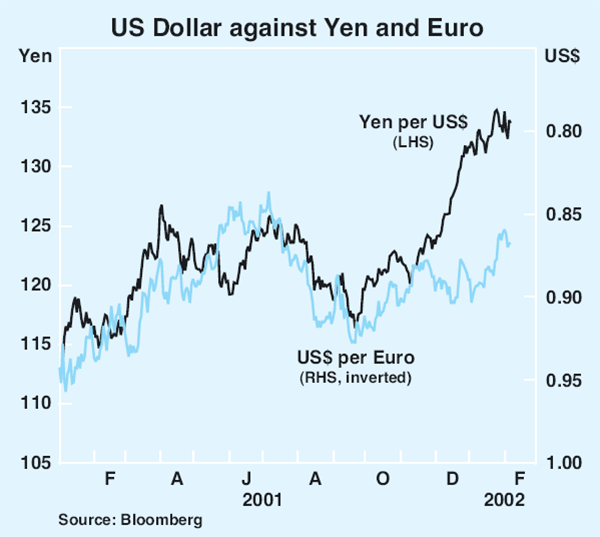
The safe-haven flows that were evident in the aftermath of the terrorist attacks, which saw funds flow to countries with large financial surpluses such as Switzerland and Japan, seem to have been largely reversed. These flows had caused the Swiss franc to rise by about 7 per cent against the US dollar in the days after September 11, but most of this rise has since been unwound. The appreciation of the yen which occurred during that period has been more than reversed.
The Argentine peso was devalued by 29 per cent on 7 January with an official rate of 1.40 peso per US dollar operating for trade and capital transactions, and a floating rate applying for retail and tourist transactions. However, most foreign exchange transactions were undertaken at the floating rate, with the official rate abandoned in early February. Since the devaluation, trading in the peso has been very thin, with the floating rate fluctuating between 1.7 and 2.2 pesos per US dollar. In contrast, the Brazilian and Chilean currencies have appreciated against the US dollar. Currencies of Asian emerging markets that float have been broadly stable over the past few months.
Australian dollar
The past three months have been a fairly steady period for the Australian dollar, with the exchange rate generally in the range of 51–52US cents (Graph 19). It has risen against most other major currencies in recent months, particularly against the Japanese yen. The exchange rate against the yen has recently been close to 70, which is the highest reading for a couple of years and about 25 per cent above the recent low in September 2001. The rate against the euro has risen to a little under 60, towards the top end of the range it has been in since late 1999. The close correlation between the Australian dollar and the euro that had been a focus of market attention, particularly in 2000, seems to have broken down somewhat recently, as the economic circumstances of Australia and Europe have diverged.
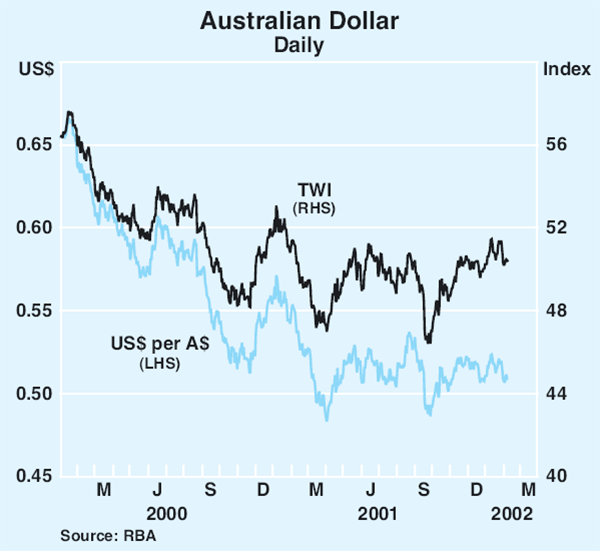
Reflecting this strength against these major currencies, the TWI has risen over the past few months. It is up about 2 per cent from its average level in the second half of 2001. The current level of the TWI, at 50.4, is nonetheless about 10 per cent below its long-run average.
Apart from the instability that followed the terrorist attacks, the Australian dollar has been in a fairly steady range since April last year. This stands in sharp contrast to the fall of about US15 cents (or 25 per cent) that took place over the previous 15 months.
As discussed in earlier Statements, capital flows data seem to confirm that international fund managers lost interest in the Australian equity market in 2000, most likely because of the then fashionable view that Australia was an ‘old’ economy. Foreign portfolio investment into Australian equities turned negative in 2000, whereas it had been running at around $15 billion a year through 1998 and 1999. At the same time, investment in foreign equities by Australian fund managers also increased (Graph 20). The puzzle was that all this took place at a time when the US share market was falling sharply, while the Australian market continued to strengthen. Since the start of 2000, US share prices have fallen by 26 per cent, while Australian shares have risen by 10 per cent.
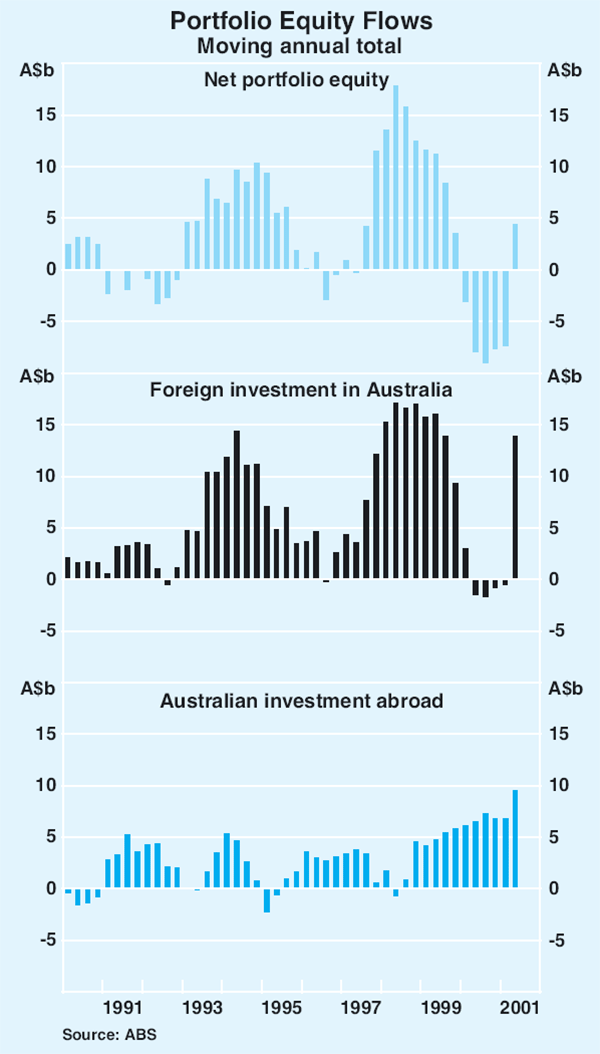
The strong outperformance of the Australian share market appears to have been recognised more recently. Inflows of portfolio investment into Australian equities strengthened markedly again by mid 2001 (the latest data available are for the June quarter 2001), returning to around their levels of 1998 and 1999. This apparent reversal in sentiment towards Australian investments may have been a factor in the greater stability of the exchange rate over the past 10 months.
Flows into Australian bonds have also turned positive again, after having been negative for most of the period since 1997 (Graph 21). The widening interest differential in Australia's favour over the past year would have been an important factor in this. Increased demand by Japanese retail investors for Australian bonds has been particularly noticeable. Following a period of minimal flows between 1997 to 2000, Australian dollar Eurobond issuance made to the Japanese retail market, known as A$ Uridashi issues, increased sharply over the second half of 2001 (Graph 22). About A$5.0 billion of such issues were made in the second half of last year, which was greater than the previous peak seen in the mid 1990s (though not as large as the dual currency issues of the mid 1990s).[1]

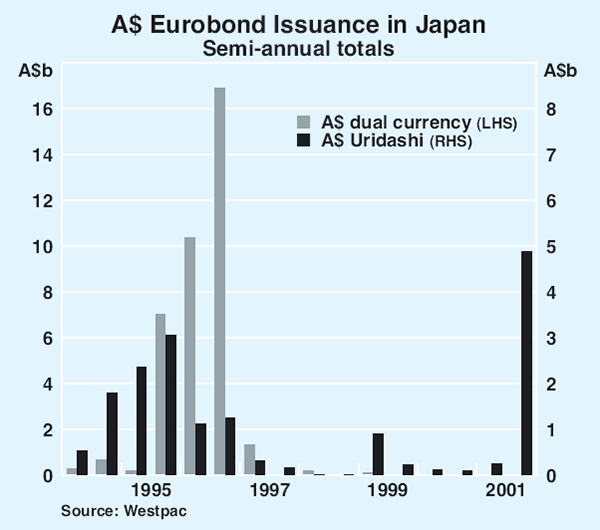
Net flows of direct investment into Australia remain negative (Graph 23). This is not because foreign companies have stopped investing in Australia; the flow of investment into Australia from foreign companies remains solid. Rather, Australian companies have sharply increased their direct investment abroad.
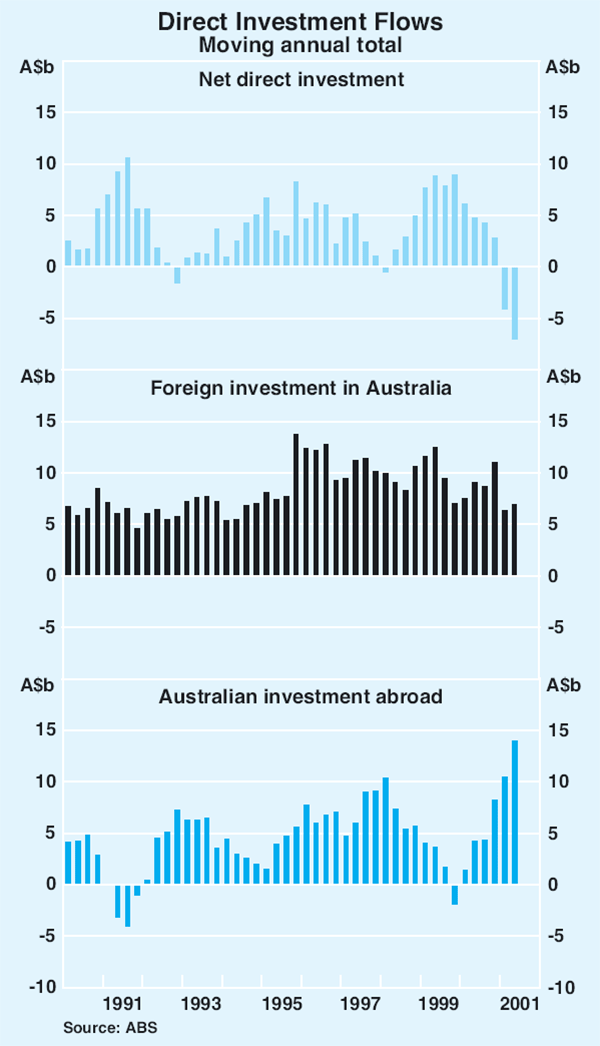
Given the recent stability of the exchange rate and orderly market conditions, the RBA has not undertaken any foreign exchange intervention over the past three months. Sales of foreign exchange to the Government have totalled $1.6 billion, but these have been largely offset by earnings in reserves and other foreign exchange transactions. As such, there has been little change in net reserves over the past three months.
Box A: US Corporate Earnings
Interpretation of earnings data from US companies has become more difficult recently as different measures are showing quite wide divergences (Graph A1).
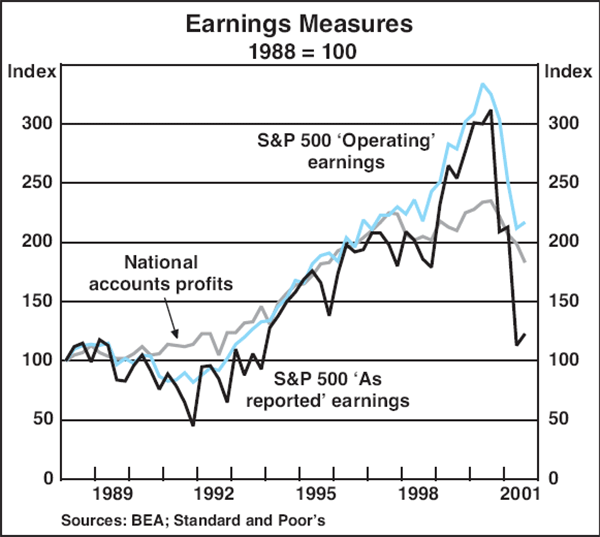
The National Accounting estimate of profits remains the best available, as it is consistent over time, and captures all profits earned by US companies. However, equity markets focus mainly on aggregate earnings for the companies in the S&P 500.
There are several ways in which S&P 500 earnings are reported. Historically the focus was on ‘as reported’ earnings, which includes all receipts less expenses, as defined by generally accepted accounting principles (GAAP). However, over recent years market analysts and companies have increasingly focused on ‘operating’ earnings (also known as ‘pro forma’ or ‘as if’ earnings). These are intended to adjust for special one-off items to give a clearer picture of ongoing profits. The problem, however, is that there are no official guidelines for what items can be added in or taken out, as ‘operating’ earnings is not a concept defined under GAAP. The Wall Street Journal has estimated that more than 300 companies in the S&P 500 now publish measures of operating earnings which fail to take full account of expenses, which would be classified as ordinary expenses and hence subtracted from earnings calculated under GAAP.
Over 1999 and 2000, the S&P measures of earnings rose much faster than the National Accounts measure. An important reason for this is said to have been the practice of firms not including the cost of options granted to employees as an expense. The National Accounts adjusts for this. Also, throughout this time operating earnings remained higher than ‘as reported’ earnings.
More recently, the S&P measures have fallen sharply. In the year to the September quarter 2001, ‘as reported’ earnings of S&P 500 companies fell by 61 per cent and ‘operating’ earnings fell by 33 per cent. The National Accounts measure fell by 22 per cent over the same period.
The divergence in earnings reports has complicated the calculation and interpretation of traditional benchmarks of share valuation such as price earnings ratios. Historically, P/E ratios for the S&P 500 have been calculated by dividing the current level of share prices by the latest actual 12 months of ‘as reported’ earnings. Using this method, the P/E ratio for the S&P 500 has recently risen strongly, to around 40 – well above the historical average of around 14, and the highest level seen over the past century. Using the last 12 months of ‘operating’ earnings as the denominator, the S&P 500 P/E ratio is around 26. While this is below the P/E ratio calculated using ‘as reported’ earnings, it remains well above the historical average.
When valuing shares, it is future earnings which are most relevant. The aggregate P/E ratio for S&P 500 companies, based on estimates of the coming year's operating earnings, is 21. This is below the other measures, but still relatively high. The assumed rise in operating earnings in the coming year, which underlies this figure, is 36 per cent. This would require a very strong recovery in the US economy.
Domestic Economic Activity
Growth in the Australian economy strengthened over the course of 2001 against a backdrop of weakening world economic conditions. GDP increased at an annualised rate of 4 per cent over the three quarters to September 2001, after a period of declining output over the second half of 2000 (Graph 24, Table 7). The deterioration in the world economy has been reflected in a switch in the composition of Australian growth from external to domestic demand, with the external sector subtracting from growth over the second half of 2001 after contributing 2 percentage points to growth over the preceding year. Growth in final demand accelerated in most states over the year to the September quarter 2001, with Western Australia and Queensland amongst the fastest growing states over this period, while NSW continued to lag behind.
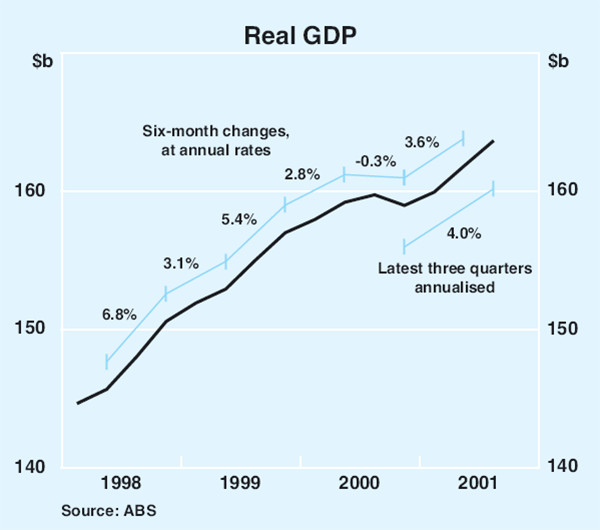
| Six months to: | September quarter 2001 |
||
|---|---|---|---|
| December quarter 2000 |
June quarter 2001 |
||
| Private final demand(a) | −2.6 | 1.9 | 1.9 |
| Consumption | 0.6 | 2.6 | 0.8 |
| Dwelling investment | −31.2 | 2.4 | 13.7 |
| Business investment(a) | −2.0 | −2.7 | 1.9 |
| Public final demand(a) | 0.1 | 1.0 | 0.5 |
| Domestic final demand | −2.0 | 1.7 | 1.6 |
| Change in inventories(b) | 1.0 | −0.6 | −0.9 |
| Exports | 2.2 | 1.5 | −1.6 |
| Imports | −2.8 | −3.1 | −1.0 |
| Net exports(b) | 1.1 | 1.0 | −0.1 |
| Gross domestic product | −0.1 | 1.8 | 1.1 |
|
(a) Adjusted for transfers between the public and private sectors Source: ABS |
|||
The outlook for domestic demand remains positive. Forward indicators suggest that the dwelling sector should continue to contribute to growth in the first half of this year. Businesses are also expected to increase investment over the course of 2002, with no sign at an aggregate level of a significant investment or inventory overhang. Indices of consumer and business confidence have also improved and are currently at levels typically associated with at least trend growth in output. However, the contribution to growth from dwelling investment is likely to fade around the middle of 2002, and may subtract from growth in the latter part of the year. There is also some risk that weakness in the labour market may dampen consumer spending.
Household consumption
Growth in household spending was firm throughout 2001 following a period of weakness over 2000. Consumer spending rose by 0.8 per cent in the September quarter to be around 3½ per cent higher than a year earlier. Growth in the volume of retail sales slowed in the December quarter, with sales increasing by 0.5 per cent, to be 4.8 per cent higher than a year earlier (Graph 25). The slowdown was largely a result of a decline in spending on hospitality and services, in part reflecting a drop-off in tourism. Over the course of the year, household spending on goods accelerated modestly while spending on services grew quite rapidly.
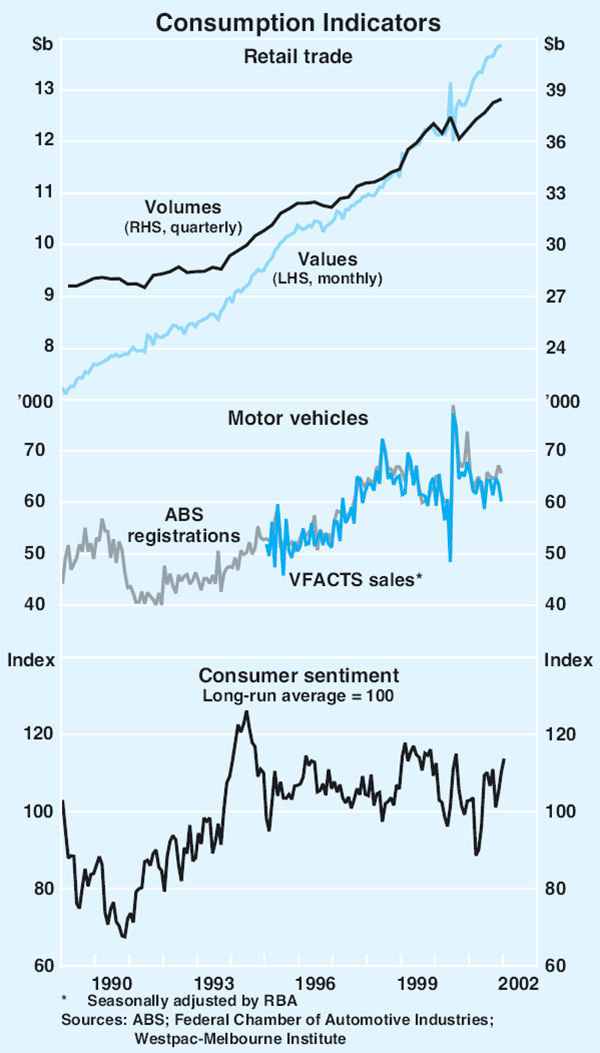
The increase in the growth of the consumption of goods reflects the flow-on from the rebound in housing activity to purchases of household furnishings, with sales of household goods and sales at department stores recovering over the year. Food retailers continue to experience strong growth in turnover, although this partly reflects higher prices. Sales of motor vehicles have steadied following a GST-related surge in the second half of 2000.
Spending on health services has continued to make a large contribution to growth in consumption. While comprising only 5 per cent of consumption expenditure, health spending has accounted for around one-third of the increase in consumption over the past year. This mainly reflects the rise in demand for health services associated with the large increase in the number of people taking out private health insurance over the past few years in response to government initiatives. With the proportion of the population with health insurance levelling out, growth in spending on health services may ease in coming quarters. In contrast, spending on hotels, cafes and restaurants has weakened in recent months, after growing strongly earlier in the year, reflecting the adverse effects on the domestic tourism industry of the recent downturn in overseas arrivals and the collapse of Ansett.
The solid pace of consumption growth seems consistent with trends in consumer sentiment. According to the Westpac-Melbourne Institute measure, consumer sentiment has rebounded in recent months, to be well above the level prevailing prior to the terrorist attacks in the US. The indices of sentiment relating to personal finances and economic conditions remain above their long-run average levels, with the latter at particularly high levels. Sentiment towards buying a major household item has risen to its highest level since mid 1999.
Household income growth has not been overly supportive of consumption, with real gross household income increasing at an annualised pace of 2 per cent in the six months to September, mainly reflecting the subdued growth in employment over this period. Nonetheless, household spending power has been boosted by the decline in petrol prices, which fell by about 12 per cent over the year to the December quarter. Household interest expenses also declined over the course of 2001, in line with the easing in monetary policy.
Consumption spending has been supported by the high level of household assets and an ongoing expansion in debt (Graph 26). The value of household assets declined marginally in the September quarter, with strong gains in dwelling prices more than offset by a sharp fall in equity values. However, equity markets have subsequently retraced these losses. Higher household asset values have supported continuing strong growth in household indebtedness by bolstering sentiment and boosting collateral values for existing owners of assets. Household credit grew at an annualised rate of 16½ per cent over the six months to December, up from 13 per cent over the six months to June, driven by significant increases in lending for housing to both owner-occupiers and investors. Growth in personal credit has slowed, though some of the growth in housing indebtedness may reflect drawdowns of existing home loans to finance consumption spending. Growth in household borrowing has led to a further increase in the ratio of household debt to disposable income, a trend evident in Australia over the past decade.
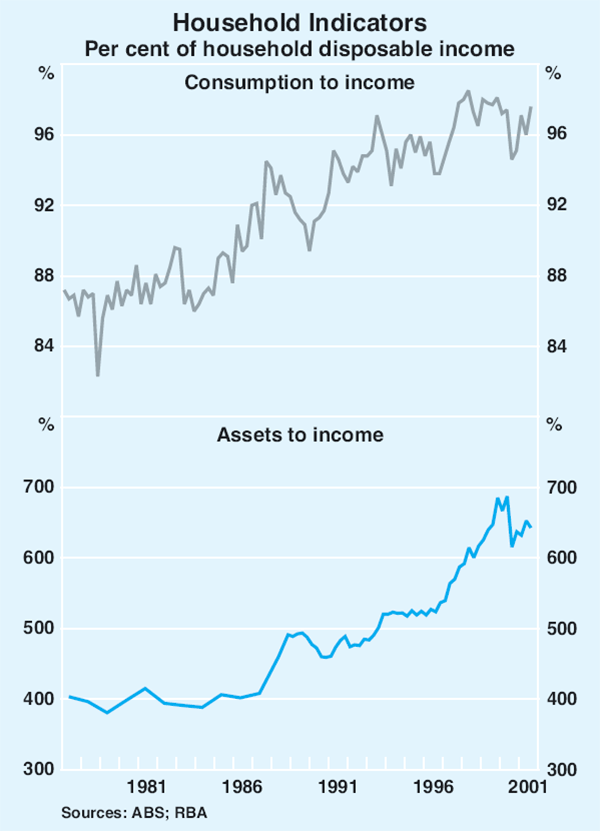
Over that period, the Australian household sector has moved from having a relatively low level of debt by international standards to a position where the debt-to-income ratio is comparable to that in other countries (Graph 27), consistent with an adjustment to deregulated financial markets and lower interest rates. It is not clear what would be a sustainable debt-to-income ratio in the longer term, but some deceleration in the growth of household indebtedness would be desirable in coming years. While both balance-sheet and cash-flow measures, such as assets-to-debt and interest-payments- to-income ratios, show that the aggregate household financial position is sound, the increase in indebtedness leaves the sector more sensitive to changes in interest rates and asset values.
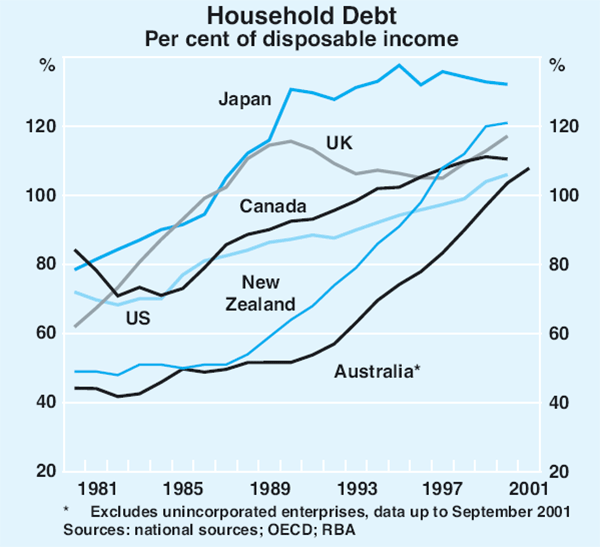
Housing
Dwelling investment rebounded strongly in the second half of 2001. The recovery began earlier in the smaller states, which had a disproportionate take-up of government incentives for first-home buyers. Construction of new dwellings increased by 23 per cent in the September quarter while spending on alterations and additions continued to rise, albeit less rapidly. The high level of building approvals and loan approvals for new construction in the second half of 2001 suggests that dwelling investment will continue to contribute to growth over the next couple of quarters.
There are signs, however, that building approvals may have reached a peak, with a moderate easing in approvals data in recent months (Graph 28). Loan approvals for new construction have also fallen and in November were 5 per cent lower than their peak in July. Information collected by State Revenue Offices indicates that the number of First Home Owner Grants paid fell in December (Graph 29). A fall was also evident, but less pronounced, in the Commonwealth Additional Grant paid for new housing.
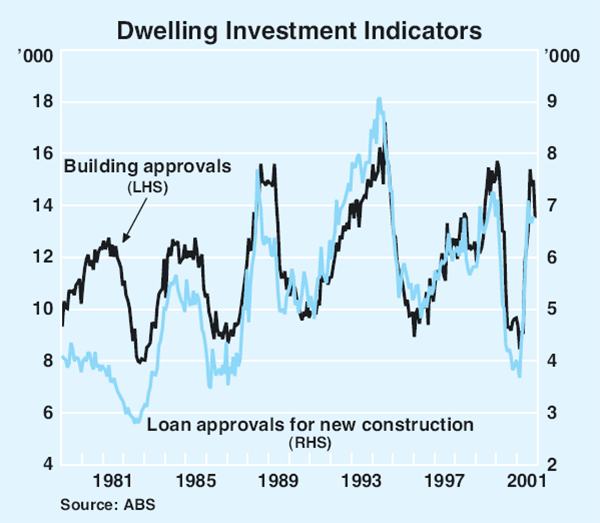
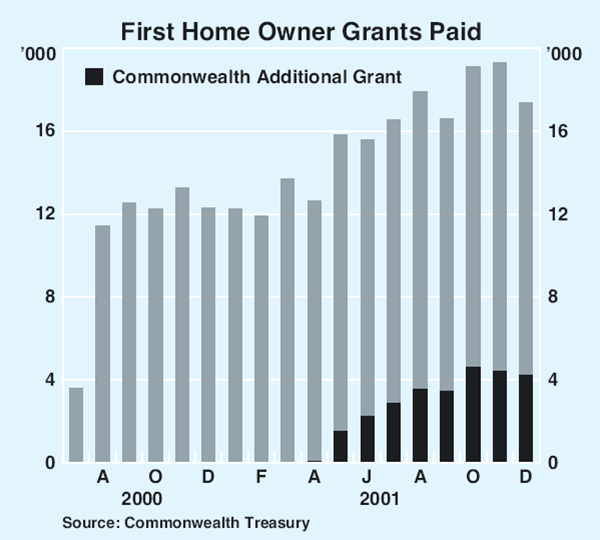
In November, the Government announced some changes to the Commonwealth Additional Grant, which should reduce the transitional impact when the scheme expires. The changes extend the scheme from end December 2001 to end June 2002, while reducing the amount of assistance in the interim period from $7,000 to $3,000. The expiration of the scheme should not have as large an effect on the dwelling cycle as the introduction of the GST. The scheme only affects first-home buyers, who accounted for a little more than 30 per cent of loan approvals for owner-occupation (excluding refinancing) in the second half of 2001, compared with an average share of around 26 per cent over the past decade.
Nonetheless, the strength of building approvals in the second half of 2001 suggests some moderate degree of oversupply is developing in parts of the housing market. Oversupply is particularly evident in medium-density dwellings, where there are high vacancy rates in some states. Vacancy rates for rental accommodation in Sydney are at a high level of just over 4 per cent, while the vacancy rate in Melbourne, at almost 5 per cent, is at its highest level since the early 1990s.
The strong growth in housing demand has maintained upward pressure on house prices in most capital cities (Graph 30). According to stratified ABS data, which attempt to remove the effect of compositional change in the sample of houses sold, the larger capital cities all recorded growth in house prices of more than 5 per cent over the year to the September quarter. Melbourne recorded the strongest increase – over 30 per cent – though Sydney, Adelaide and Canberra also recorded double-digit growth. The strength in Melbourne house prices is consistent with Victoria's relatively strong economic performance in recent years and the resultant net inflow of migrants from other states which have increased demand for property.
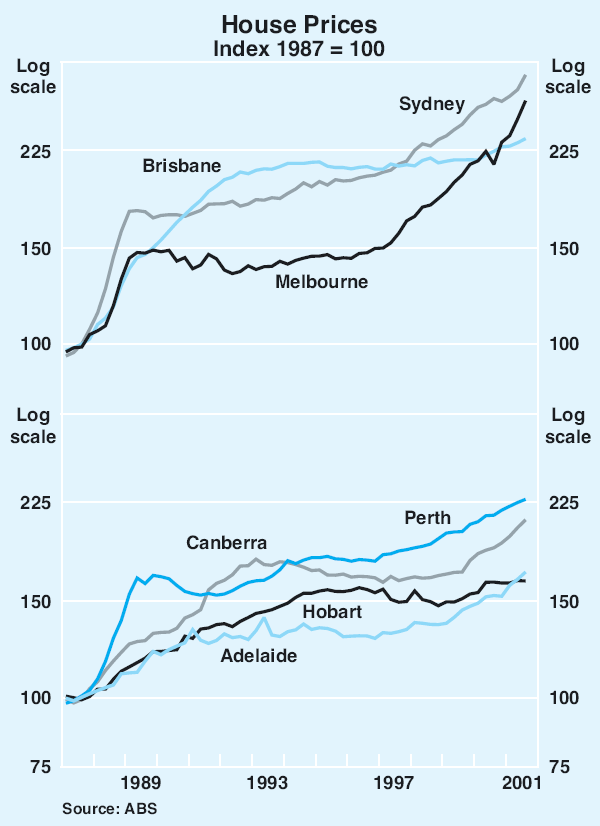
The business sector
While output continued to expand at a solid pace over 2001, there has been a change in the composition of growth (Table 8). The upswing in the residential construction cycle and the continued strength in retail trade in recent quarters has flowed on to the wholesale and manufacturing industries. The farm sector has also recorded solid growth in recent quarters, reflecting, in part, a recovery in the Australian wheat crop and strong beef and veal production.
| Six months to: | ||
|---|---|---|
| March quarter 2001 |
September quarter 2001 |
|
| Goods production | −3.1 | 3.8 |
| Goods distribution | 0.4 | 2.1 |
| Business services | 3.4 | 2.1 |
| Household services | 2.2 | 0.4 |
|
Source: ABS. For details of sector classifications refer to ‘Box A: The Service Sectors’ in the November 2001 Statement on Monetary Policy. |
||
In contrast, growth in the service sectors, which has contributed strongly to economic growth in recent years, is beginning to slow. Growth in business services has eased further in recent quarters due mainly to the shake-out in the telecommunications industry. Recent adverse developments in the tourism sector may result in a further slowing in the household services sector. Domestic aircraft movements at major airports have recovered from the disruption in September, but remain below their usual levels. International passenger movements, which have increased significantly from their recent trough, also remain below normal. Bookings with inbound tour operators point to the possibility of further weakness in international arrivals in coming months. Reflecting developments in the airline industry, hotel occupancy continues to be low, especially in areas reliant on business and overseas travel. This has been partially offset by increased tourism activity in some regions that are readily accessible by car.
Business surveys have generally reported a rebound in business conditions to a level consistent with robust growth (Graph 31). The economy-wide quarterly NAB business survey reported that the index of business conditions in the December quarter remained above its long-run average, with improvements reported by the transport and storage, retail and rural sectors, although conditions in communications, finance, business and property services and recreational and personal services were reported to have deteriorated. The NAB quarterly survey reported a decline in business confidence, but the more recent monthly survey for December showed a marked rebound in confidence. The ACCI-Westpac survey and other surveys pertaining to the manufacturing sector have reported that business conditions in the December quarter remained strong, as manufacturing continues to benefit from the flow-on effects of the increase in residential construction activity. Business conditions of small and medium-sized enterprises, as reported in the Yellow Pages survey, improved in the three months to October though they are not as strong as the economy-wide measures.
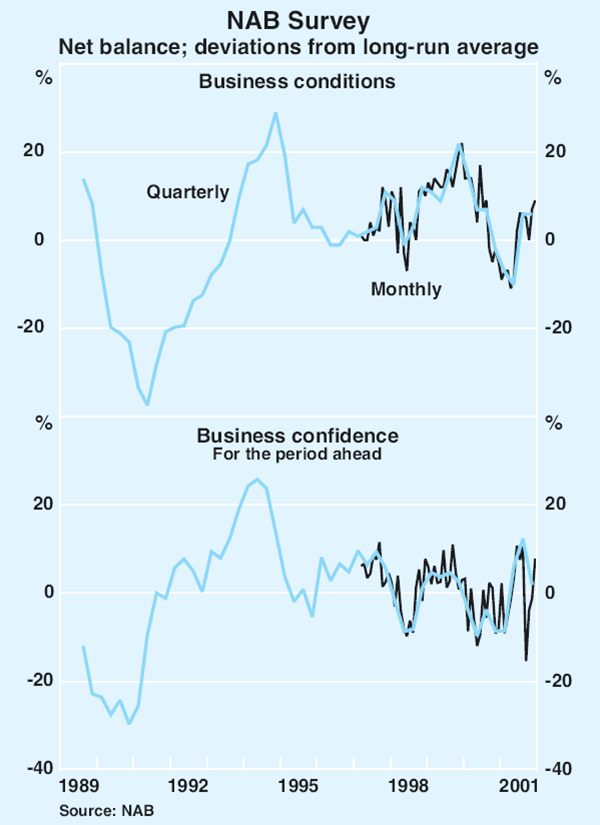
Business investment increased in the September quarter by nearly 2 per cent in volume terms, with investment in machinery and equipment and buildings and structures both rising. Investment in intangible fixed assets has contracted over the last two quarters after recording very strong growth in previous years. The fall in the September quarter was primarily driven by declines in mineral and petroleum exploration. Expenditure on computer software, which accounts for most of intangible fixed asset investment, rose slightly in the September quarter after falling in the previous period, though growth remains relatively subdued in the context of generally weak conditions for the ITC sector.
Investment as a share of GDP remains low by historical standards, indicating that there is scope for a recovery in investment in the period ahead (Graph 32). The ABS capital expenditure (Capex) survey indicates moderate growth in overall business investment this financial year though the expected increase in investment is narrowly based. Much of the growth is expected to come from the mining sector, reflecting strong profits in that sector in recent years as well as a relatively high level of capacity utilisation, though investment in the transport and storage sector is also expected to contribute significantly. Investment intentions for 2001/02 in most other industries declined in the September quarter. Strong growth in mining-sector investment intentions is also reflected in the Access Economics Investment Monitor.
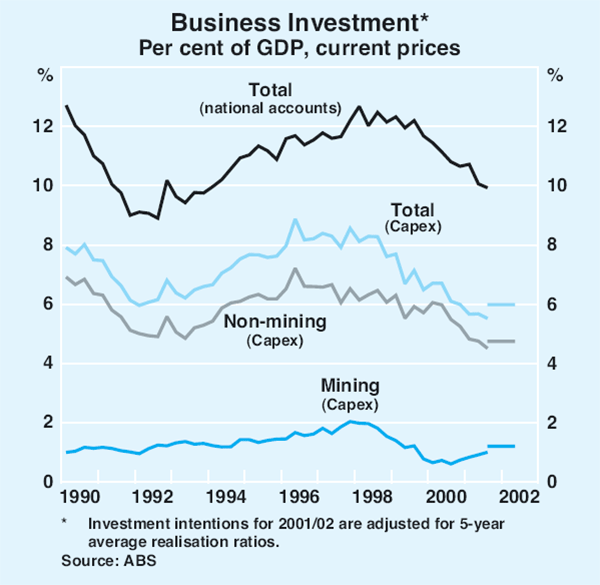
Investment intentions for machinery and equipment, as reported in the Capex survey, suggest modest growth in 2001/02 in nominal terms. The large upward revision to expected investment in the transport and storage sector is most likely due to planned fleet expansions and upgrades being undertaken by the domestic airlines. Machinery and equipment investment in the manufacturing and communication industries is expected to decline in 2001/02.
Forward-looking indicators of buildings and structures investment suggest that a recovery in this type of investment is underway. The value of commencements and work yet to be done on engineering construction by the private sector rose strongly in the September quarter. The latter probably reflected the commencement of two major projects – the fourth train expansion of the North-West Shelf LNG plant, projected to cost $1.6 billion over three years, and the Darwin-Alice Springs railway line, projected to cost $1.3 billion over the same period. A number of resource-related projects are also expected to commence in the next two years. Non-residential building activity was broadly flat over most of 2001, but the strength in approvals during the year and the build-up in work yet to be done in recent quarters suggests that a pick-up in non-residential construction activity can be expected. The low levels of vacancy rates for office property in the capital cities remain broadly supportive for investment, though there has been a mild increase in vacancies in recent quarters, in line with some rationalisation in the finance, insurance and technology sectors.
The softness in investment in recent quarters and the expectation of only moderate growth in the near term has been reflected in business funding (Graph 33). The deceleration in the pace of growth of external funding over the second half of 2001 primarily reflected weakness in intermediated business borrowing. However, the quarterly pattern suggests a mild acceleration in the pace of growth of business credit in recent months and business loan approvals also appear to have stabilised. Market capital raisings continued apace, with equity raisings in particular remaining at high levels, in line with strength in equity prices.
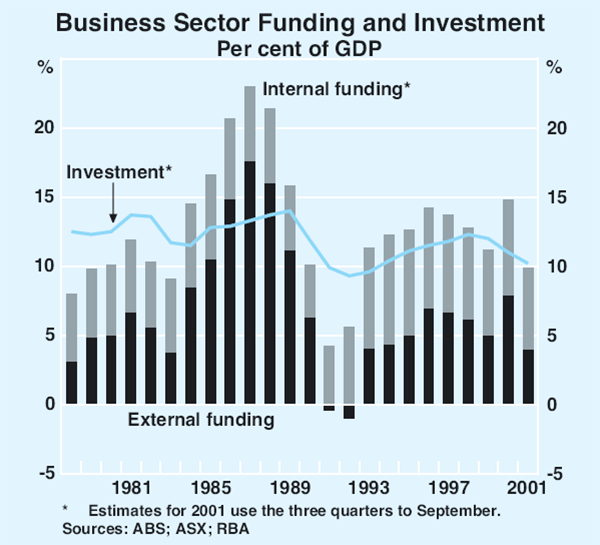
Corporate sector profits as measured by GOS were little changed in the September quarter, and as a share of GDP they remained at levels slightly below the average of the past decade (Graph 34). Reflecting the strength in domestic demand, domestically oriented sectors reported improved profitability in the September quarter after falling substantially over the preceding year. The profitability of small businesses, as measured by GOS of unincorporated enterprises, increased by 5.7 per cent in the September quarter, after a period of subdued performance, reflecting the pick-up in the housing and retail sectors.
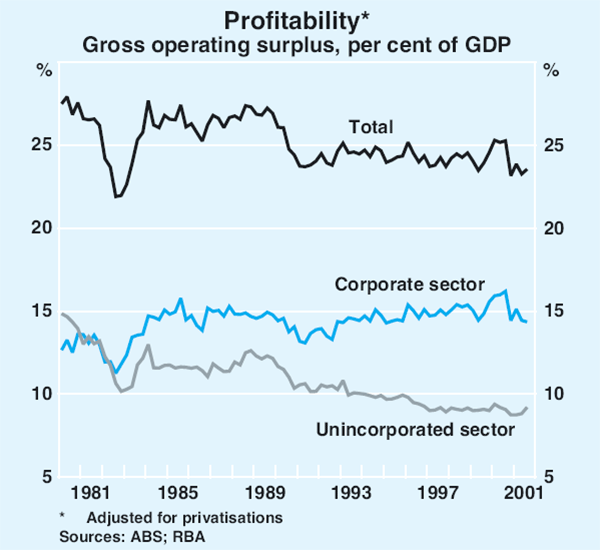
Aggregate indicators suggest that the financial position of businesses remains sound. The interest burden remains at very low levels, with recent reductions in official interest rates serving to lower the cost of funds to corporates further (Graph 35). The recent emphasis on equity raisings, rather than debt, has contributed to a lower aggregate corporate debt-to-equity ratio.
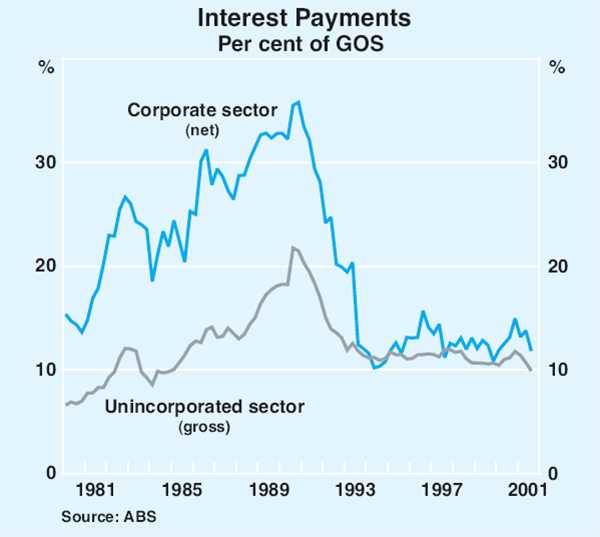
The labour market
The recovery in output growth in 2001 is not yet evident in the labour market, which remains weak (Graph 36). Employment grew marginally in the December quarter and was only 0.9 per cent higher over 2001. Full-time employment grew by 0.1 per cent in the December quarter but was 1.1 per cent lower over the year. Part-time employment also increased by 0.1 per cent in the December quarter, but was 6.2 per cent higher over the year. The weak demand for labour has seen the unemployment rate rise by almost ¾ of a percentage point from its trough in September 2000. The participation rate continues to be volatile, but has been broadly flat over the past two years.
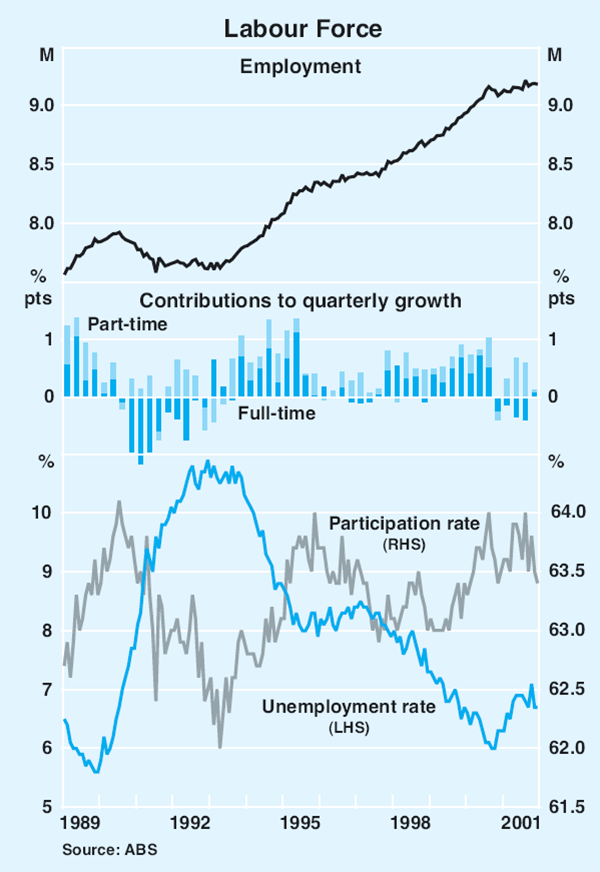
Reflecting the developments in economic activity, there continue to be divergent trends in employment growth across industries (Table 9). The most significant weakness has been in business services employment, which fell by 3.6 per cent in the December quarter and by 4.7 per cent over the year. Employment in the household services sector rose slightly in the December quarter, following disruptions to activity in the tourism industry. The recovery in the dwelling sector has been reflected in strong growth in employment in construction and, to a lesser extent, manufacturing.
| Growth | |||
|---|---|---|---|
| Share of total 2001 |
December quarter |
Year to December quarter |
|
| Goods production | 21 | 1.6 | −0.5 |
| Manufacturing | 12 | 0.7 | −2.8 |
| Construction | 7 | 3.5 | 3.2 |
| Goods distribution | 24 | 0.9 | 2.5 |
| Retail and wholesale | 20 | 1.1 | 2.9 |
| Transport and storage | 5 | −0.1 | 1.0 |
| Business services | 17 | −3.6 | −4.7 |
| Property and business services | 12 | −3.1 | −7.0 |
| Finance and insurance services | 4 | −2.2 | 5.7 |
| Communication services | 2 | −8.9 | −10.2 |
| Household services | 28 | 0.2 | 3.8 |
| Accommodation, cafes and restaurants | 5 | −2.1 | −4.8 |
| Education | 7 | −0.2 | 4.2 |
| Health and community services | 10 | 1.4 | 6.6 |
| Cultural and recreational services | 2 | 3.7 | 1.0 |
|
(a) For details of sector classifications refer to ‘Box A: The Service Sectors’ in the November 2001 Statement on Monetary Policy. Excludes agriculture and public administration. Source: ABS |
|||
Labour productivity, as measured by output per hour worked in the economy, increased by 2.0 per cent in the September quarter and by 4.2 per cent over the year (Graph 37). This suggests that the higher trend productivity growth that has been observed over the 1990s has been regained, after a cyclical slowdown in 2000. Labour productivity in the construction sector has returned to more normal levels having been unusually low in 2000/01, as employment in the construction sector has continued to improve, but at a slower pace than the rebound in housing activity.
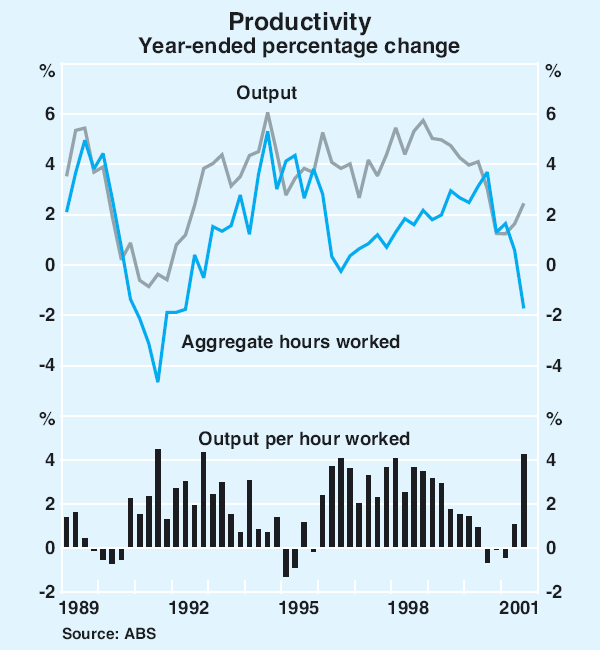
Queensland recorded the fastest employment growth over the year to the December quarter, although the unemployment rate in that state remains above the national average (Table 10). NSW was the only state to record a fall in employment in the December quarter and, with the exception of Tasmania, had the lowest growth in employment over the year. The relatively weak labour market performance in NSW has been associated with the largest increase in state unemployment rates.
| Employment growth | Unemployment rate | ||||
|---|---|---|---|---|---|
| December quarter |
Year to December quarter |
December quarter |
Year-ended change |
||
| NSW | −0.6 | 0.5 | 6.4 | 0.9 | |
| Victoria | 0.2 | 0.9 | 6.6 | 0.7 | |
| Queensland | 0.3 | 1.7 | 8.0 | 0.4 | |
| WA | 0.8 | 0.7 | 7.0 | −0.2 | |
| SA | 1.0 | 1.1 | 6.4 | 0.4 | |
| Tasmania | 1.3 | −1.2 | 8.6 | 0.0 | |
| Australia | 0.1 | 0.9 | 6.8 | 0.6 | |
|
Source: ABS |
|||||
Forward-looking indicators of the labour market have stabilised in recent months but remain at relatively low levels (Graph 38). All measures of job vacancies remain significantly lower than their peaks in mid 2000. The sharp increase in the ANZ series in January has brought it back into line with the Department of Employment and Workplace Relations (DEWR) series, which was broadly unchanged in January, following a strong increase in December. The ABS employer-based measure of vacancies fell by 1.9 per cent in the December quarter to be 23 per cent lower than a year ago, which represents a continued easing in the rate of decline in this measure. Survey-based measures of employment intentions remain at, or above, levels that are consistent with trend employment growth. On balance, these indicators present a firmer tone than in recent quarters, but suggest that labour market conditions are not likely to change significantly in the near term.
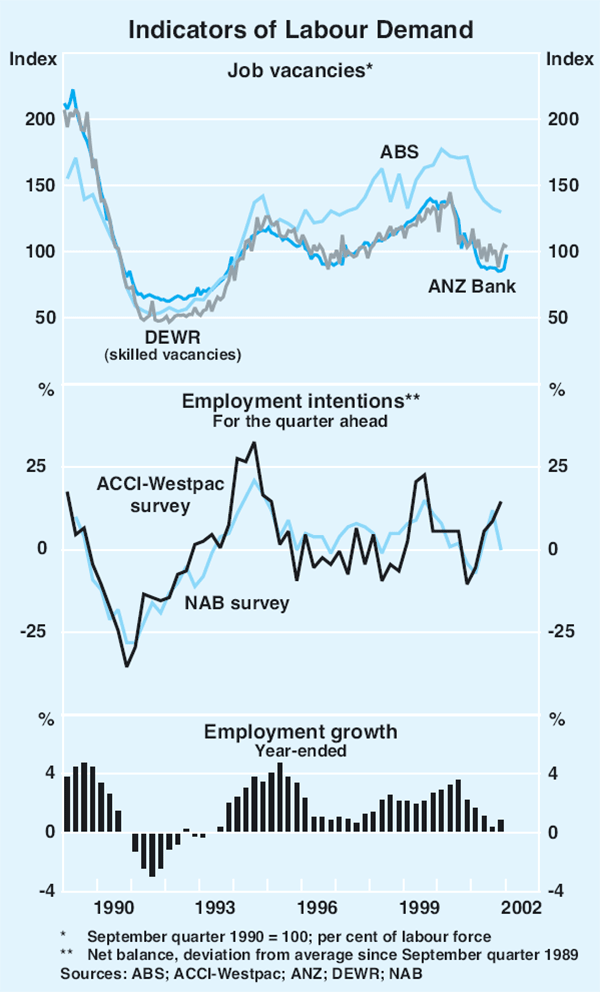
Balance of Payments
After a couple of years of strong growth, the export sector contracted in the second half of 2001 as the world slowdown took effect (Box B). With export volumes falling in the December quarter, and stronger domestic demand contributing to a significant increase in import volumes, net exports subtracted considerably from growth in GDP in the quarter, following a modest subtraction in the September quarter. Export prices, which had been resilient to the slowing world economy, fell slightly in the December quarter, contributing to a small decline in the terms of trade. As a result of these movements, the balance of trade moved into deficit in the December quarter, following three quarters of trade surpluses. Assuming the net income deficit remained constant as a share of GDP, this implies that the current account deficit in the December quarter is likely to have increased from its recent low of 1.6 per cent of GDP in the September quarter, to be around 3½ per cent of GDP (Graph 39).

In contrast to the previous period of trading-partner weakness during the Asian crisis, the synchronised weakness in the world economy has limited the scope for export diversion. Nonetheless, Australian exporters appear to be making some inroads into markets in the Middle East and south Asia, with merchandise exports to these regions still growing strongly (Table 11). Exports to east Asia, however, have been weak: total exports of resources to Singapore and Indonesia almost halved over the past year, while total exports of manufactures to Singapore, Hong Kong and Taiwan have fallen by almost 25 per cent. Exports to Korea have held up due to the strength of domestic demand there. Exports to Japan have fallen over the past year, with resource exports, which constitute around 70 per cent of Australia's merchandise exports to Japan, accounting for much of the slowing. While merchandise exports to China fell over the past three months, this follows a period of very strong growth.
| Growth | |||
|---|---|---|---|
| Year to December quarter 2000 |
Year to December quarter 2001 |
Share of total 2001 |
|
| Japan | 29.8 | −4.7 | 20.0 |
| Europe | 9.1 | 4.9 | 11.8 |
| United States | 32.3 | −6.4 | 10.2 |
| East Asia (excluding Japan) | 41.5 | −3.5 | 33.0 |
| – Korea | 27.0 | 11.7 | 7.5 |
| – China | 57.9 | 10.3 | 6.5 |
| – Taiwan | 42.7 | −21.8 | 4.3 |
| – Singapore | 82.1 | −15.6 | 3.6 |
| – Indonesia | 47.0 | −3.4 | 2.7 |
| – Malaysia | 18.0 | 3.6 | 2.1 |
| New Zealand | 10.9 | 2.8 | 6.1 |
| Middle East | 46.1 | 24.7 | 4.9 |
| South Asia | 11.3 | 17.9 | 2.3 |
| Rest of the world | 34.4 | 1.8 | 11.8 |
|
(a) Excludes gold Source: ABS |
|||
Resource exports appear to have fallen in both value and volume terms over the second half of 2001, after growing solidly over the previous two years (Graph 40). Exports of coal have levelled out after recording strong growth over 2000. Demand for thermal coal is expected to remain firm owing to the continued commissioning of new coal-fired power stations in Asia and the reduction in subsidies paid to European coal producers in recent years, though Australia is facing increased competition from China. Coking coal exports are also expected to remain at a high level, with the expected fall in Japanese steel production offset by increases in Korea, Taiwan and some European countries; in addition, lower US and Canadian coking coal output has led to tighter supply conditions. Aluminium demand, along with demand for the other major base metals, has fallen in recent months amid ongoing economic weakness in the US and Japan, and contractions in demand from south-east Asia and Europe.

The growth in rural export values over the past year has reflected large increases in the price of rural commodities, with rural export volumes declining over the course of 2001. Cereal export volumes have fallen modestly, following very strong wheat production in the last two financial years. Further falls in wheat production in 2001/02 are expected by the Australian Bureau of Agricultural and Resource Economics (ABARE), though the fall in exports is expected to be smaller due to a rundown in stocks. Meat export volumes remain at a high level, though beef and veal production is expected to be slightly weaker in the current financial year. With consumer demand for beef in Japan falling following the detection of ‘mad cow’ disease in Japanese herds, and exports to the US running up against import quotas, some beef is being diverted to other markets, particularly in east Asia. Wool export volumes have fallen over the past 18 months as a consequence of reduced supply, due to a switch in farming production from wool to meat. Supply has been tightened further by the elimination of the wool stockpile last August.
The effect of the slowdown in world economic conditions has been most pronounced in manufacturing and service exports. Manufactured export volumes recovered slightly in the December quarter after falling by 8½ per cent over the previous two quarters. Machinery exports fell by 22 per cent over the same period, but increased in the December quarter. Exports of transport equipment were flat over the past year, though this follows annualised growth of 14½ per cent over the preceding two years.
Service exports fell in the December quarter owing mainly to the adverse effect on global tourism of the September terrorist attacks in the US (Table 12). In line with global trends in passenger movements, short-term visitor arrivals to Australia in the December quarter fell by 14 per cent, following a 1 per cent fall in the previous quarter. Short-term arrivals from the US, UK and east Asia (excluding Japan) fell sharply following the terrorist attacks in the US, but by December they had recovered most of the fall. In contrast, arrivals from Japan and New Zealand remain on a downward trend.
| Growth | |||
|---|---|---|---|
| December quarter 2001 |
Year to December quarter 2001 |
Share of total 2001 |
|
| East Asia (excluding Japan) | −12.2 | −9.3 | 26.5 |
| New Zealand | −8.4 | −27.5 | 15.2 |
| Japan | −17.7 | −29.1 | 14.0 |
| United Kingdom | −8.3 | −3.7 | 12.8 |
| Europe (excluding UK) | −10.4 | −11.6 | 12.1 |
| United States | −13.9 | −17.7 | 9.2 |
| Total | −13.7 | −16.6 | 100.0 |
|
(a) Seasonally adjusted by RBA Sources: ABS; RBA |
|||
Import values have been weaker over the past year owing to a fall in volumes (Graph 41). In the December quarter, however, import volumes increased. The strength in imports of consumption goods in the quarter was mainly accounted for by food and beverages and motor vehicles. Imports of capital goods, which experienced particularly large falls towards the end of 2000 and in early 2001, rebounded strongly in the second half of the year, reflecting a rise in machinery and equipment investment. Further rises in capital goods imports are expected during 2002 as a result of fleet expansions and upgrades being undertaken by the domestic airlines. In aggregate, imports from east Asia and the US have fallen in recent months, while imports from Japan, and particularly Europe, have held up over this period.
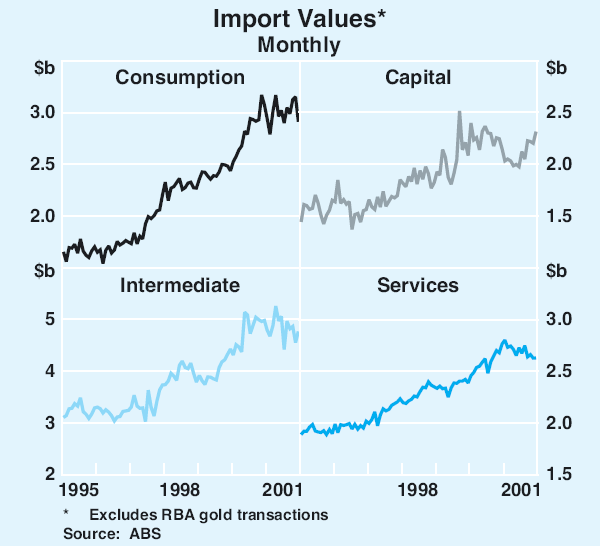
Consistent with lower interest rates globally, the net income deficit narrowed further in the September quarter, to 2.8 per cent of GDP. Debt-servicing ratios remain low by historical standards, with the ratio of net interest payments to exports remaining around 9 per cent in the September quarter.
Australia's net foreign debt increased in the September quarter to $331 billion, equal to 49 per cent of GDP (Graph 42). Consistent with trends over the past couple of years, the increase was driven primarily by debt inflows, with the modest depreciation of the Australian dollar in the quarter also boosting the Australian-dollar value of foreign-currency denominated debt. Net foreign equity liabilities also rose, despite net equity outflows from Australia. The rise primarily reflected the valuation effect of the strength in the Australian share market relative to those abroad. Overall, net foreign liabilities increased to around 60 per cent of GDP.
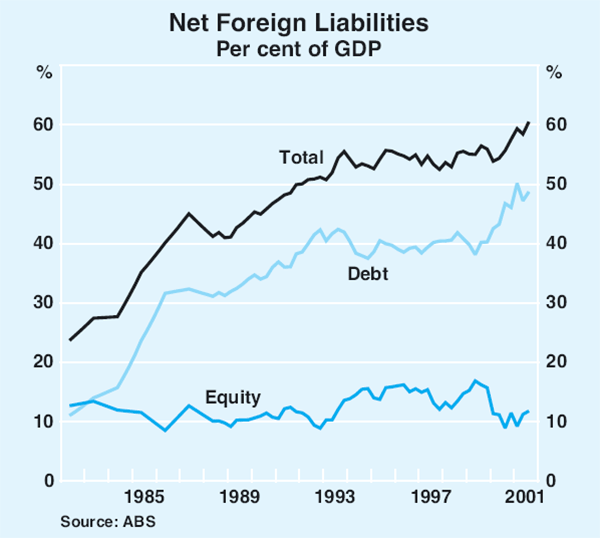
Commodity prices
Oil prices in recent months have traded at levels well below those prevailing during the previous two years (Graph 43). The weaker world economic outlook, and the reluctance of non-OPEC oil-producing countries to cooperate with OPEC in cutting production levels, contributed to the weakness in oil prices in the latter part of 2001. More recently, however, an agreement from major non-OPEC countries, including Russia and Norway, to cut production in conjunction with OPEC's own cuts has contributed to a mild recovery in the oil price around the turn of the year. Since the end of 2000, OPEC production quotas have been reduced on four separate occasions, amounting to a 19 per cent reduction in quota volumes.
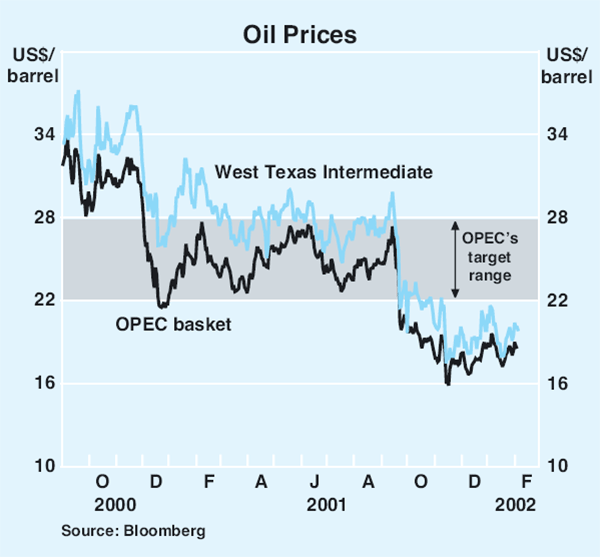
The RBA commodity price index, in SDR terms, has increased in recent months to be just below its recent peak and around 19 per cent higher than its low point in 1999 (Graph 44, Table 13). In Australian dollar terms, the index is 42 per cent above the trough reached in May 1999. Base metals prices have recovered in recent months owing to a reassessment by markets of the risks to the world outlook, as well as cutbacks in production of a number of base metals, though stocks continue to rise. The increase in aluminium prices has been more muted. Some cuts in aluminium production have been announced, but have been offset by substantial increases in production in China and Russia.
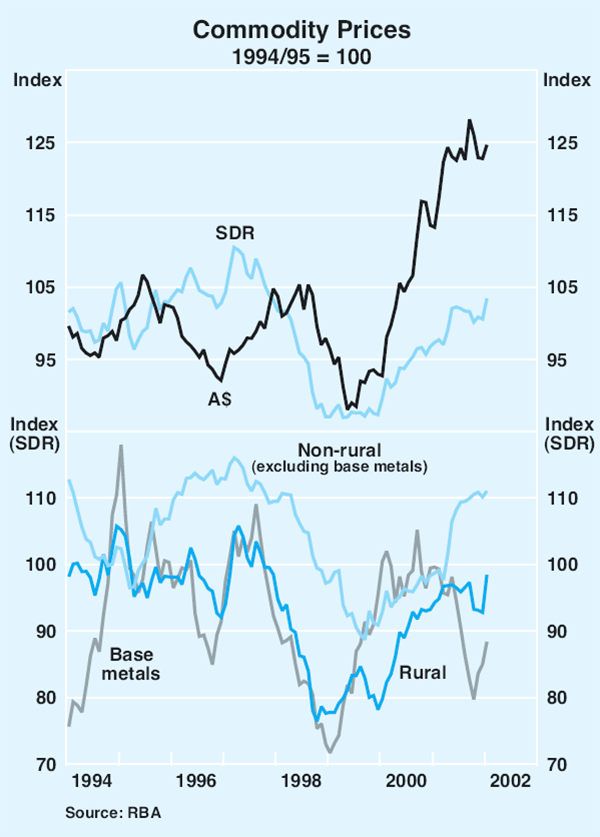
| January | Latest 3 months | Year to latest 3 months |
|
|---|---|---|---|
| Rural | 6.1 | −1.0 | 1.4 |
| – beef and veal | 6.8 | −5.3 | 19.2 |
| – wool | 15.0 | 3.4 | 2.0 |
| – wheat | 1.4 | 1.6 | 1.6 |
| – sugar | 0.3 | −2.4 | −21.4 |
| Base metals | 3.9 | 3.4 | −13.0 |
| – aluminium | 2.3 | 2.5 | −10.9 |
| – copper | 3.2 | 4.7 | −16.8 |
| – nickel | 13.1 | 9.0 | −21.6 |
| – lead | 5.7 | 6.2 | 7.9 |
| Other resources | 0.8 | 0.6 | 12.8 |
| – gold | 2.7 | 0.8 | 6.3 |
| RBA Index | 2.8 | 0.5 | 5.2 |
| Memo items: | |||
| Oil in US$(a) | 1.6 | −23.2 | −36.7 |
| Coal in US$(b) | −5.3 | −11.5 | 5.6 |
| (a) Oil prices are not included in the RBA Index (b) Spot price for steaming coal from the Australian Coal Report; latest observation is for December |
|||
Rural commodity prices eased towards the end of 2001, but have recovered strongly in the new year and are around 28 per cent higher than the lows recorded in the late 1990s. Beef and veal prices, after falling towards the end of 2001, have recovered owing to stronger US demand. Wool prices have moved higher again and are back above their two-year highs reached in April 2001. Very tight supply conditions – Australian wool production is at a 50-year low – have more than offset weaker consumer demand for wool products from Japan and the US, while Chinese demand appears to be picking up. Wheat prices remain high owing to reduced output by major wheat exporters. Sugar prices have been on a downward trend over the second half of 2001 due to upward revisions to estimates of world production, particularly from Brazil.
Non-rural commodity prices have changed little over the past three months. Gold prices gradually moved higher over 2001 as the downward trend in gold production, which has been evident for several years, continued. Reports of likely oversupply of thermal coal, arising from increased Chinese supply, led to a fall in the spot price during November from the high levels prevailing in the previous couple of months. More recently, prices have steadied around US$27 per tonne, thereby restoring the typical gap between the contract and spot price (Graph 45). Contract prices for thermal and coking coal and iron ore are currently being renegotiated, with new contract prices to become effective in April.

Box B: Direct Effects of a Weakening World Economy on Australia
The world economy has a significant influence on developments in the Australian economy through its effects on Australia's exports, both in terms of the amount sold and the price received for them, relative to the cost of imports. The scope of this channel has increased through time as the Australian economy has become more open.
The current slowdown in world growth is forecast by the IMF to be of a similar magnitude to the early-1990s slowdown for the industrial countries, but not as large as that in the mid 1970s or early 1980s. Reflecting the global slowdown, Australian export volumes declined in the September and December quarters. The terms of trade have remained relatively resilient. Despite falling in the December quarter, they are still higher than a year earlier, as import prices have fallen further than export prices (in foreign-currency terms).
To provide some context for the current situation, Table B1 documents episodes over the past 40 years where declines in export volumes or the terms of trade have subtracted at least 1 percentage point from domestic incomes. The table shows that some of these episodes occurred when the world economy was in recession, but a number of episodes were associated with only a relatively mild slowdown in world growth. Some of these differences reflect the extent to which Australia's trading partners were affected relative to the rest of the world. The table also shows that significant declines in export volumes and the fall in the terms of trade have rarely occurred simultaneously, with the Asian crisis being a notable exception. In that episode, the combined effects of a decline in export volumes and lower prices reduced Australian national income by around 2½ per cent – considerably more than in any of the three world recessions of the 1970s, 1980s and early 1990s.
| Episode (year-ended) | Export volumes | Episode (year-ended) | Terms of trade |
|---|---|---|---|
| December 1960 | −1.7 | March 1965 | −1.0 |
| March 1974 | −1.4 | March 1971 | −1.7 |
| December 1980 | −1.1 | March 1975 | −1.7 |
| June 1998 | −1.0 | September 1977 | −1.4 |
| March 1986 | −1.6 | ||
| June 1991 | −1.2 | ||
| June 1993 | −1.0 | ||
| December 1998 | −1.5 |
These three world recessions had contrasting effects on the external sector. The decline in export prices in foreign-currency terms was considerably larger in the early 1990s than in the other two episodes, although the terms of trade decline was greatest following the 1970s recession reflecting rapid growth of import prices. However, whereas export volumes declined in both the 1970s and 1980s episodes, in the early 1990s, export volumes grew at a relatively rapid pace, increasing by 13 per cent in 1991 and by 5½ per cent in 1992.
In each of these three episodes, the effect of lost foreign earnings on national income was not large enough, in itself, to cause a recession – even allowing for the operation of a multiplier as demand and production responded to the initial loss of income. While international forces contributed to the severity of the recessions in the 1970s and 1980s, it was a contraction in domestic demand that was the more powerful force. This was even more the case in the early 1990s, where international factors did not have a significant negative effect on the economy through the external sector, yet Australia experienced a recession because domestic demand fell sharply during the process of unwinding the imbalances of the late 1980s. During the Asian crisis, in contrast, the strength of domestic demand kept the economy growing quite strongly, despite the pronounced contractionary influence from abroad.
This simple analysis suggests that while a pronounced weakening in global growth does affect Australia, whether or not this leads to a recession depends critically on the extent to which the Australian economy is already suffering from domestic problems. If the economy is relatively free of imbalances, there is a good chance that, even though the pace of GDP growth will moderate, an outright contraction in economic activity can be avoided.
Domestic Financial Markets
Market interest rates
At the time of the last Statement, in early November, short-term interest rates reflected expectations of substantial further monetary easings over the following six months; they amounted to between 75 and 100 basis points from the then cash rate of 4.5 per cent (Graph 46). These expectations were significantly unwound over the following weeks as concerns faded about the impact of the events of September 11 on global activity. Some of this had already happened by the time of the RBA's December Board meeting and its decision to ease by 25 points at that meeting was in line with market expectations. After that meeting, there were lingering expectations for a few weeks of another 25 point easing some time in the first half of 2002, but over recent weeks those too have disappeared as economic data here and in the US have continued to improve. This trend was reinforced by the Australian CPI result for the December quarter being higher than market expectations.
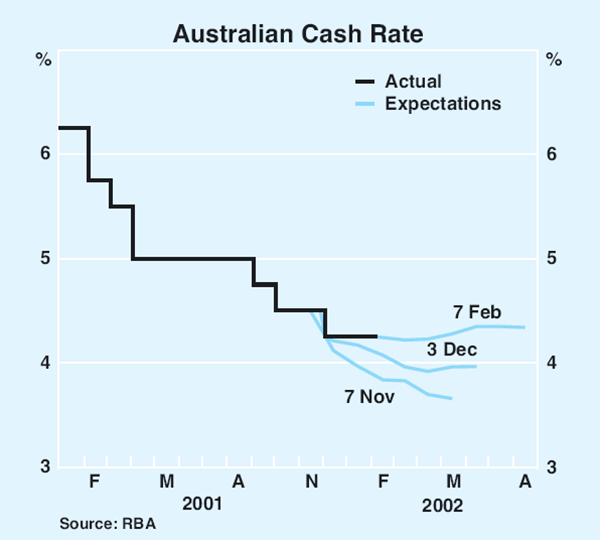
These changing expectations have not had much impact on yields on 90-day bills. They have been around 4.25 per cent over the past two months – i.e. broadly in line with the current cash rate. The changes have been more evident in slightly longer-term yields, such as on 180-day bills. These have risen from around 4.2 per cent in early December to around 4.4 per cent in early February. This represents a return to a more normal relationship between the yields on the two maturities after a period of close to a year when yields on the longer bills were typically below those on 90-day bills.
With the same decline in cash rates here as in the US over the last quarter, the spread between the cash rate in the two countries has remained unchanged at 250 basis points. Markets expect this differential to narrow marginally over coming months on the back of tightening of policy in the US from the second quarter of 2002 (Graph 47).
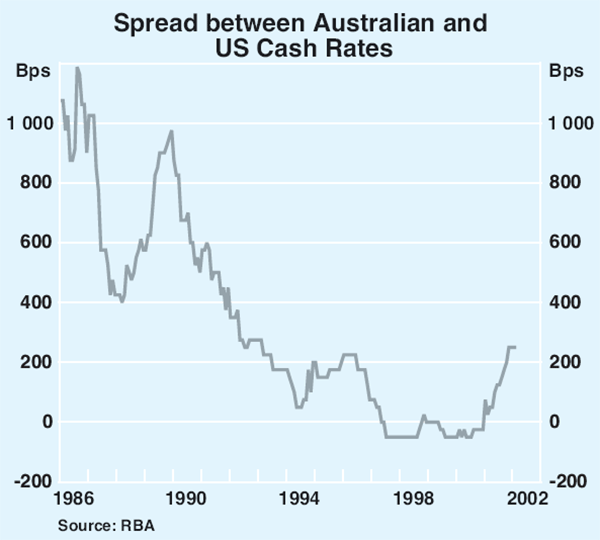
Movements in yields on medium to long-term bonds have been more pronounced than movements at the short end of the yield curve (Graph 48). Yields on 10-year bonds reached a low point of around 5 per cent in early November. This was about 50 basis points below their level at the start of 2001 and, aside from a brief period in 1998, the lowest level of bond yields since the late 1960s. Subsequently, improving confidence and reduced expectations of policy easing saw yields rise by 50 basis points, by early December, and by a further 40 basis points since (Graph 49).
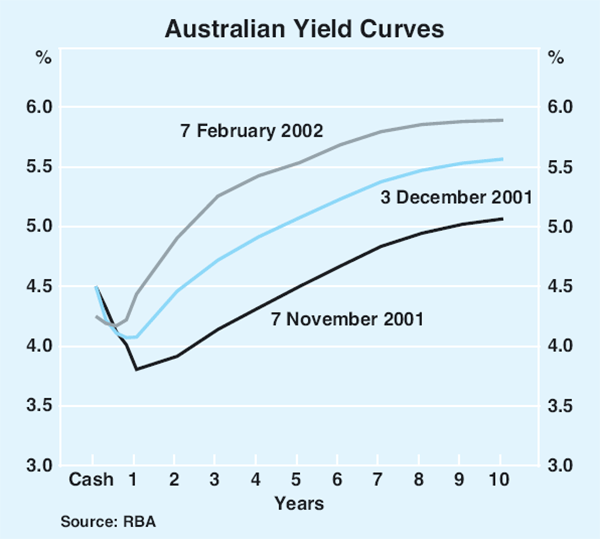
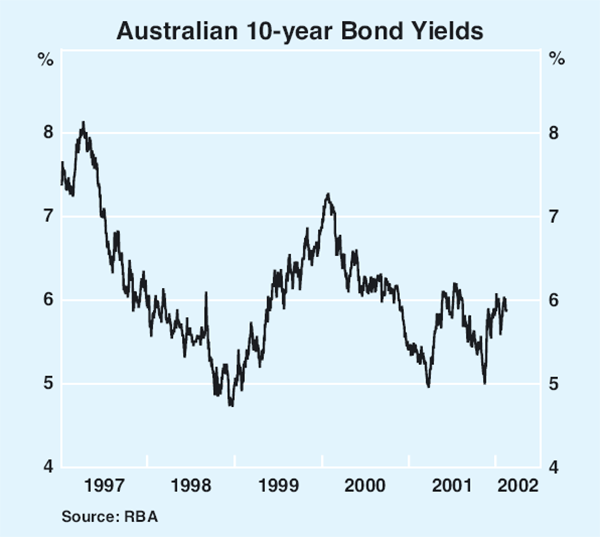
The rise in Australian bond yields over recent months has been largely in line with increases in yields in the US. The differential between Australian and US bond yields has remained within the range of 70 to 100 basis points that has prevailed since the middle of last year. More recently, the differential has been at the higher end of this range (Graph 50).
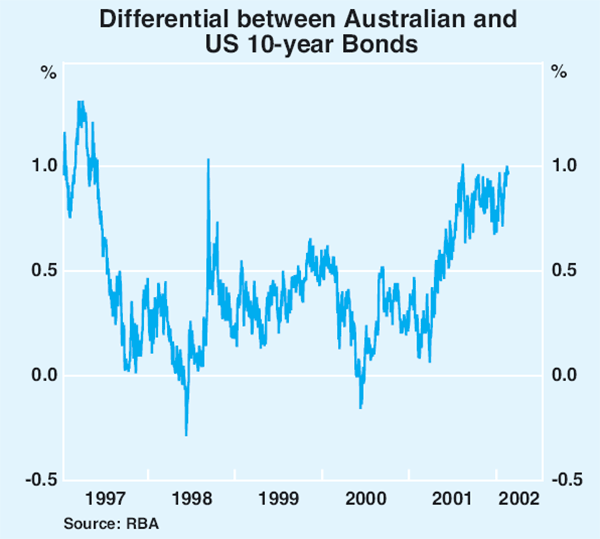
Corporate bond yields have risen by less than government bond yields over the past few months. As a result, spreads on bonds rated A or above have narrowed and are now below their pre-September 11 levels. Spreads on BBB-rated bonds remain, on average, about 10 basis points above their September levels. In general, spreads on corporate bonds in Australia have narrowed by more than, and remain well below, those in the US (Graphs 51 and 52).
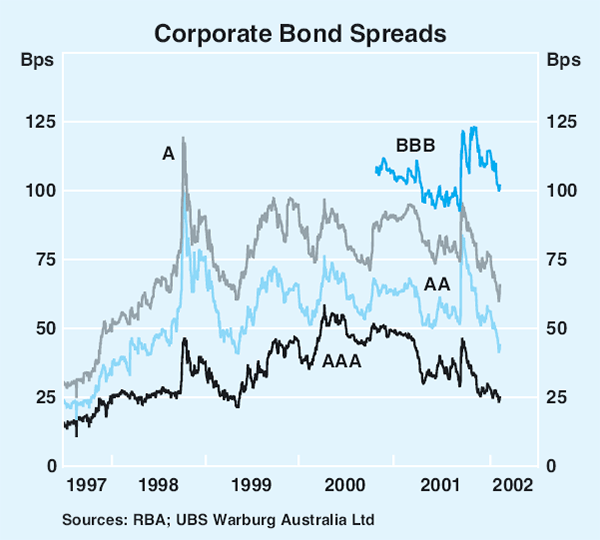

The recovery in corporate bond spreads has been most pronounced for A to AA grade bonds. Investors appear confident that these bonds are more likely to have their credit rating upgraded than downgraded. Telstra, for example, recently had its credit rating upgraded by Standard and Poor's to AA− from A+. Expectations of actual default are very low. Despite a number of prominent corporate collapses last year, there were no defaults on investment-grade bonds (the only kind on issue in Australia). In contrast, Standard and Poor's report that 0.3 per cent of investment-grade bonds worldwide defaulted in 2001, close to a record level.
Intermediaries' interest rates
The December easing of policy was passed fully onto households, with mortgage and credit card rates falling by 25 basis points.
The latest reductions in housing rates have seen them fall almost 0.5 percentage points below their 1998/99 cyclical lows (Table 14). The current standard variable rate, at 6.05 per cent, and the basic mortgage rate (5.50 per cent) remain the lowest mortgage rates since March 1970 and July 1968 respectively (Graph 53).
| Current level (early February) |
Change since October 2001 |
Change since January 2001 |
Cyclical low 1998/99 |
|
|---|---|---|---|---|
| Household | ||||
| Mortgages | ||||
| – Standard variable | 6.05 | −0.25 | −2.00 | 6.50 |
| – Mortgage managers | 5.75 | −0.25 | −2.05 | 6.10 |
| – 3-year fixed | 6.30 | 0.00 | −0.65 | 6.40 |
| Personal lending | ||||
| – Residential secured | 6.20 | −0.25 | −2.00 | 6.60 |
| – Credit cards | 15.65 | −0.35 | −1.05 | 15.25 |
| Small business | ||||
| Residential secured: | ||||
| – Overdraft | 6.80 | −0.15 | −1.80 | 6.95 |
| –Term loan | 6.25 | −0.20 | −1.95 | 6.65 |
| – 3-year fixed | 6.70 | 0.50 | −0.30 | 6.50 |
| Other security: | ||||
| – Overdraft | 7.50 | −0.15 | −1.70 | 7.45 |
| –Term loan | 6.85 | −0.30 | −1.85 | 7.05 |
| Large business | ||||
| – Overdraft | 7.85 | −0.20 | −1.90 | 7.95 |
| – Term loan | 7.70 | −0.25 | −1.90 | 7.90 |
| Cash rate | 4.25 | −0.25 | −2.00 | 4.75 |
|
Source: RBA |
||||

As with previous easings in monetary policy in 2001, pass-through to small business rates has been incomplete. Margins on small business loan indicator rates have been drifting up since November 1999 (during both the tightening and easing phases of monetary policy). They have increased most for overdrafts and loans secured by assets other than residential property (Graph 54). Despite this, the margin between the weighted average rate actually paid by small businesses and the cash rate has fallen slightly over the same period. This suggests that businesses have been able to offset the rising margins on indicator loans either by taking up special offers or switching to lower-cost products or lenders.
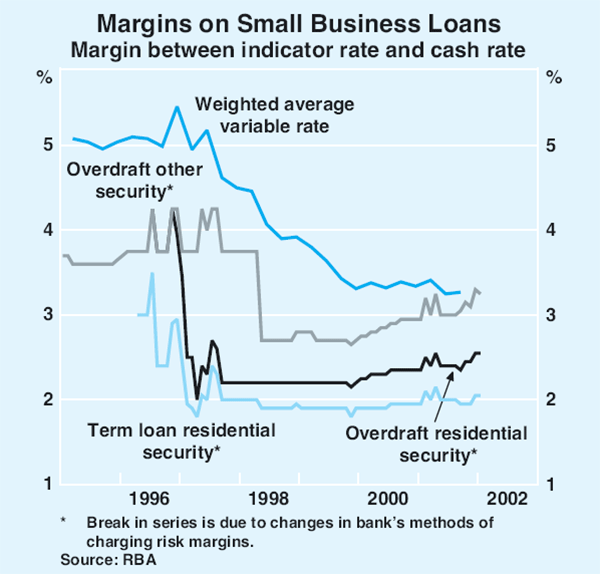
Interest rates on fixed-rate loans for housing and small business have risen in recent months, in contrast to the declines in interest rates on variable-rate loans (Graph 55). These increases have been smaller than those of swap rates, from which intermediaries price their fixed-rate loans, and fixed rates remain around the lowest seen in recent years. However, the proportion of loans at fixed rates has been declining, most likely due to the falls in variable rates. This is true for both households and small businesses.
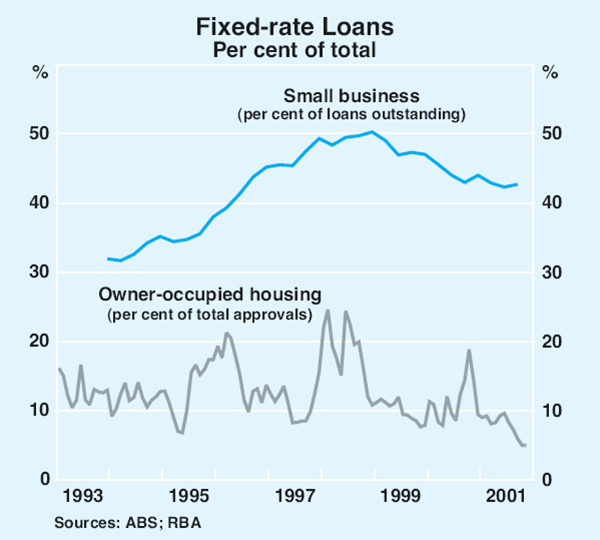
Capital markets developments
Debt markets
Issuance of both corporate and asset-backed bonds in the December quarter was down by around 20 per cent from that in the previous quarter (Graph 56). This was a fairly good outcome given the slow start to the quarter and the usual December inactivity. Corporate issuance was boosted by one large raising of $1 billion. The size of this raising is indicative of the improved capacity of the domestic corporate bond market. The raising in question was the largest without credit enhancement yet to be made by a domestic non-financial corporate.
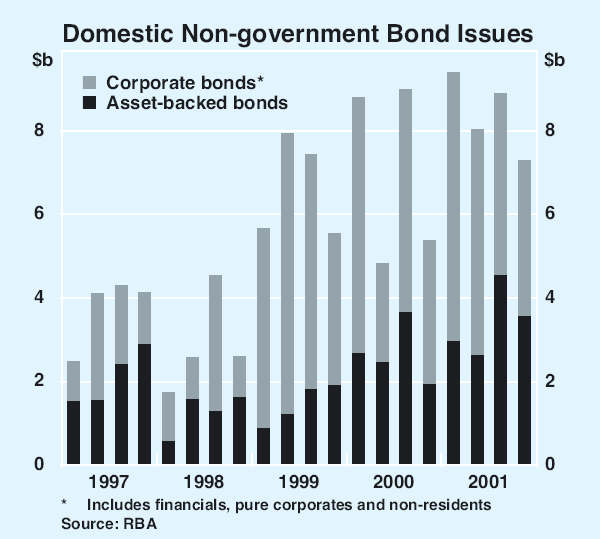
Strength in the first three quarters of the year meant that non-government bond issuance was substantially higher in 2001 than in 2000 ($33.6 billion compared to $28 billion) (Table 15). Domestic asset-backed issuance for the year was particularly strong and included a large increase in the number of smaller non-residential mortgage-backed issues. At $13.7 billion, issues of asset-backed bonds were more than twice their level two years earlier. There was also around $14 billion of asset-backed issuance into offshore markets during 2001.
| Sector | 1999 | 2000 | 2001 | 2001:Q1 | 2001:Q2 | 2001:Q3 | 2001:Q4 |
|---|---|---|---|---|---|---|---|
| Financials | 10.4 | 5.1 | 6.0 | 2.1 | 1.0 | 1.7 | 1.2 |
| Non-residents | 5.6 | 3.5 | 7.8 | 3.8 | 2.4 | 1.2 | 0.4 |
| Pure corporates | 5.5 | 8.6 | 6.1 | 0.5 | 1.9 | 1.5 | 2.2 |
| Total corporate | 21.5 | 17.2 | 19.9 | 6.4 | 5.3 | 4.4 | 3.8 |
| of which: | |||||||
| – Credit-wrapped | – | 3.8 | 2.0 | – | 1.2 | 0.8 | – |
| – Floating rate notes | 1.1 | 6.5 | 5.3 | 1.6 | 1.5 | 1.4 | 0.8 |
| Asset-backed | 6.4 | 10.8 | 13.7 | 3.0 | 2.7 | 4.5 | 3.5 |
| Total new issuance | 27.9 | 28.0 | 33.6 | 9.4 | 8.0 | 8.9 | 7.3 |
Asset-backed issuance into offshore markets has matched domestic issuance for several years and there are outstandings of about $35 billion in each market segment. Foreign investors are attracted to Australian issues due to the default history of home loans in Australia being lower than in the US and the UK, and by credit enhancement of the bonds provided by mortgage insurance. For the issuers, offshore markets are attractive because they are able to absorb large deals more readily than the domestic market.
In the domestic corporate market, one notable trend through the year was that non-residents' share of corporate issuance declined markedly. Early in the year, they had accounted for over half the corporate issues in Australia, but by the fourth quarter this proportion was down to 10 per cent. Those earlier large issues reflected opportunities for foreign companies to reduce funding costs by borrowing in Australia and swapping the proceeds back to US dollars. By late in the year, changes in spreads meant that these opportunities had been largely removed. Nonetheless, for the year as a whole, non-residents were the largest group of bond issuers in Australia.
Issues by financial institutions were up a little on the previous year but well down on earlier years. In 1999, for example, financial institutions accounted for around a half of bond issuance, and two-thirds the year before that. Issuance by domestic non-financial corporates (‘pure corporates’) declined a little in 2001 from the high figure the previous year when debt financing by former public utilities such as electricity generators and airports made large issues. There was also a decline last year in the proportion of bond issues carrying a floating interest rate.
After a number of years of very strong growth, outstandings of non-government bonds levelled out in the second half of 2001, at around $100 billion, as maturities largely offset new issues (Graph 57). Analysts expect this to be temporary, with new issuance outweighing maturities in the year ahead.
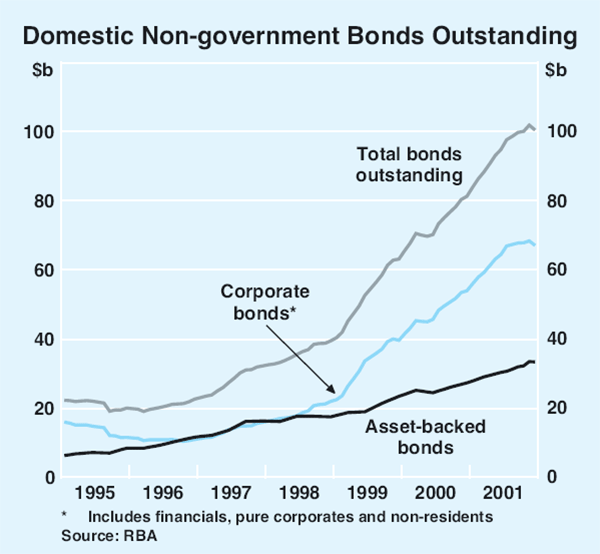
Equity markets
Australian share prices continue to be stronger than those in most other major countries, including the US. Like markets elsewhere, the Australian marked recovered strongly from the fall that followed the September events. But whereas some markets have declined again in the past month, particularly in the US where there are growing concerns about corporate governance, the Australian market has risen further. It is the only major market in the world where share prices remain close to their peak (Graph 58). In other markets, they are down around 30 per cent from their early-2000 peaks. This stronger outcome is largely mirroring the relatively strong performance of the Australian economy. Corporate profitability in Australia has remained much more robust than in the US.
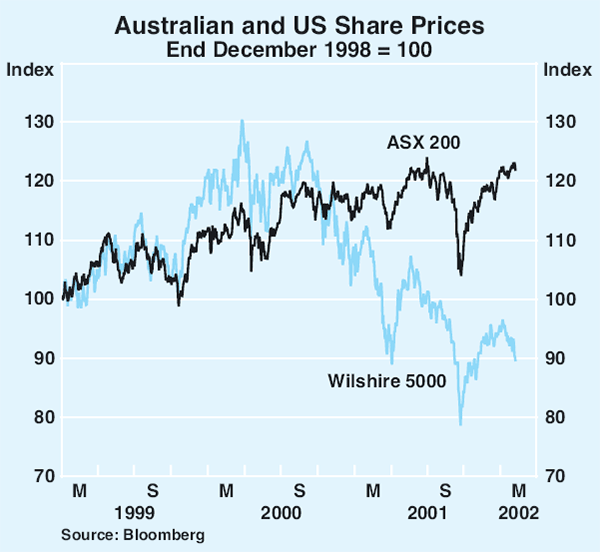
The recent strength has been in both the resource sector and the bank and insurance sector (Graph 59). The resource sector has been buoyed by good profits and takeover activity. With a solid domestic economy, bank shares have also been in strong demand as markets see little prospect of recent strong earnings growth being interrupted. The losses incurred by NAB on its HomeSide subsidiary have been seen by markets as largely one-off, and as such have not had a lasting impact on the overall banking index. Bank share prices also have not been materially affected by the collapse of Enron in the US. At $562 million, the four major banks' combined unsecured exposure to Enron increases their impaired asset ratios only a little, to around 0.65 per cent from around 0.60 per cent of their on-balance sheet assets. By historical standards, this figure remains very low.
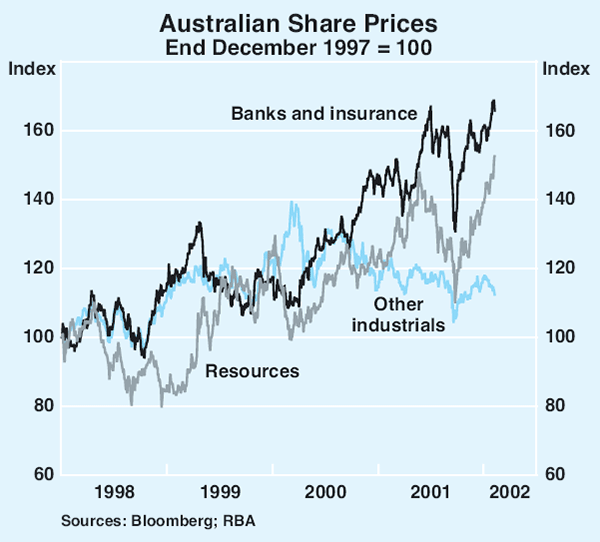
Share valuations relative to the latest profits (i.e. P/E ratios) have again risen in recent months, taking them further above the long-run average. The current aggregate P/E ratio for the Australian market is 26, up from 23 in October. The long-run average is about 15. The ratio is being supported by bullish profit expectations in the period ahead; in the current year, analysts expect industrial companies' profits to increase by 14 per cent, a very strong rate of increase.
Net equity issuance slowed during the December quarter to around $3.5 billion from $5.7 billion in the previous quarter, but was broadly in line with raisings during the first two quarters of the year (Graph 60). Net equity issuance for the whole of 2001, at $15.4 billion, was slightly stronger than in 2000.
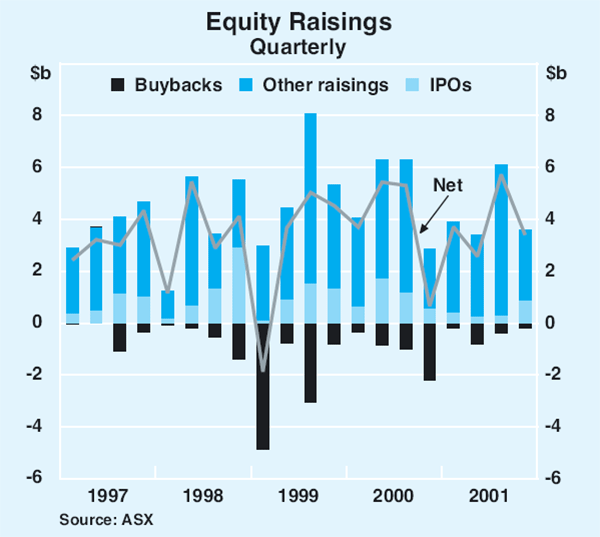
Assessment of Financial Conditions
Financial conditions continue to be expansionary. Monetary policy was eased by 25 basis points in December, reducing the cash rate to its lowest level in almost 30 years (Graph 61). The easing has translated into further falls in interest rates on loans from financial intermediaries, supporting strong expansion in credit to households; growth in business credit, however, remains subdued. Yields on financial market debt instruments are still at low levels by historical standards, notwithstanding a rise in yields on longer-dated maturities over the past couple of months that has made the slope of the yield curve more positive. Increases in equity prices have encouraged a high level of equity raisings. The real exchange rate remains low and is supportive of the traded sector.
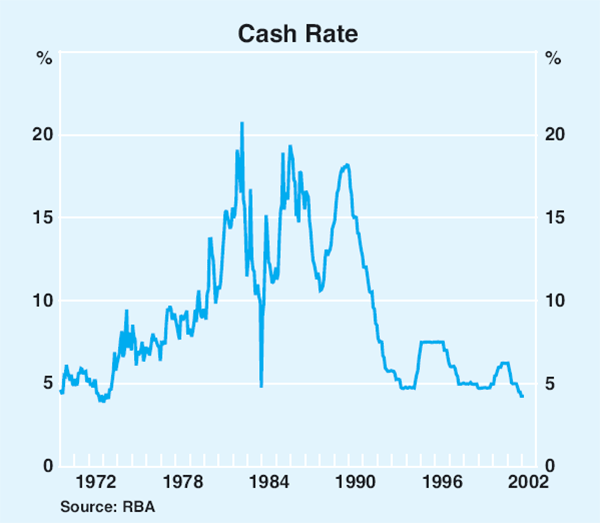
Interest rates
The 25 basis point easing in monetary policy in December took the cumulative easing this cycle to 200 basis points. An approximate benchmark for assessing the stance of policy is the average real cash rate over the period since 1992, a period in which there has been stable inflation and strong economic growth. A range of measures of real interest rates are presented in Table 16, all of which show that real interest rates are currently below that average. Based on a measure calculated from underlying inflation, the real cash rate appears highly expansionary, being 2½ percentage points below average. The deviations from average are smaller when real interest rates are calculated using inflation expectations derived from the bond market or consumer surveys. Real home loan interest rates are clearly expansionary on any of these measures, reflecting the fall in margins charged by intermediaries on housing loans over the 1990s. Real lending rates charged to business are also below average, though by a smaller margin than is the case for housing loan rates.
| Using weighted median inflation |
Using bond market inflation expectations |
Using consumer inflation expectations |
||||||
|---|---|---|---|---|---|---|---|---|
| Level | Deviation from average(a) |
Level | Deviation from average(a) |
Level | Deviation from average(a) |
|||
| Cash rate | 1.0 | −2.5 | 2.1 | −0.6 | 0.4 | −1.0 | ||
| Home loan rate | 2.7 | −3.3 | 3.9 | −1.4 | 2.2 | −1.7 | ||
| Business indicator rate | 4.6 | −2.4 | 5.8 | −0.4 | 4.0 | −0.8 | ||
|
(a) Percentage point deviation from 1992–2001 average. Sources: ABS; Melbourne Institute; RBA |
||||||||
The slope of the yield curve in Australia, as measured by the difference between 10-year bond yields and the 90-day bank bill rate, has steepened over recent months (Graph 62). This reflects more accommodative monetary policy, which has pushed short-term interest rates lower, and bond market perceptions that prospects for economic recovery have improved, which has shifted long-term interest rates higher.
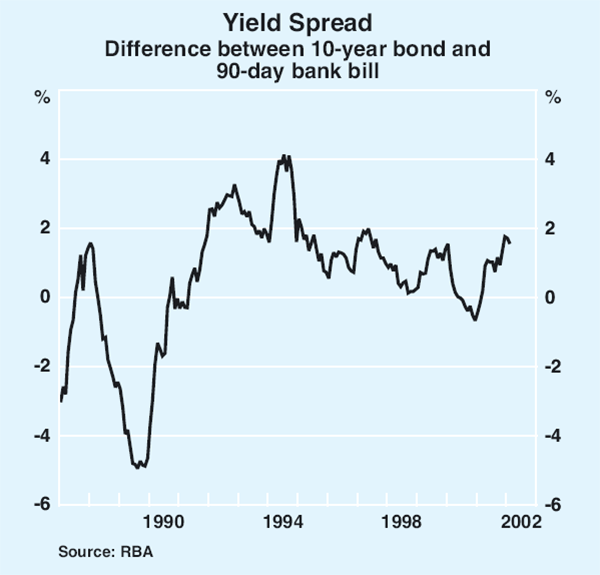
Financing activity
Credit grew at an annualised rate of around 7½ per cent over the six months to December, somewhat below the rate recorded over the previous six months (Graph 63). Borrowing activity continues to be dominated by households. Lending to households increased by an annualised rate of around 16½ per cent over the six months to December, compared with a small decline in business credit. The rapid expansion in household borrowing, driven by lending for housing, reflects low interest rates in the housing sector and the impetus from the Government's First Home Owner Grant. On the business side, surveys confirm that interest rates are not a constraint on business activities, and on-market raisings through debt and equity have maintained a solid pace. As outlined in the chapter on ‘Domestic Economic Activity’, the slower pace of overall business borrowing activity in 2001 is broadly consistent with the easing in investment expenditure over the past year or so. Loan approvals data suggest that the divergence between growth in household and business credit will narrow in coming months.
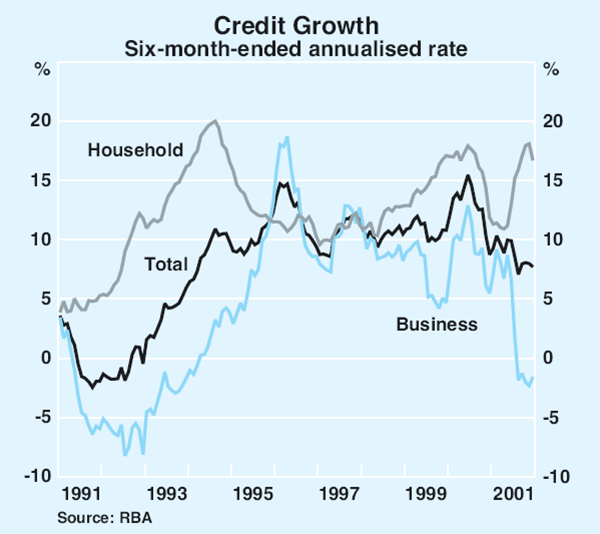
On the liability side of intermediaries' balance sheets, growth in the broader monetary aggregates accelerated over the latter part of 2001. Broad money grew at an annualised rate of 13½ per cent over the six months to December, up from 9½ per cent in June. With growth in domestically sourced liabilities now outstripping that in assets, financial intermediaries reduced their offshore borrowings over the period, in marked contrast to the strong growth in offshore borrowing recorded in recent years.
Real exchange rate
As discussed in the chapter on ‘International and Foreign Exchange Markets’, the Australian dollar was relatively stable in 2001. In December, the real exchange rate, which adjusts for differences in inflation across our trading partners, was close to its level of a year earlier, remaining around 14 per cent below its 1990s average (Graph 64). More recently, the trade-weighted value of the currency has risen a little, primarily reflecting an appreciation against the yen.
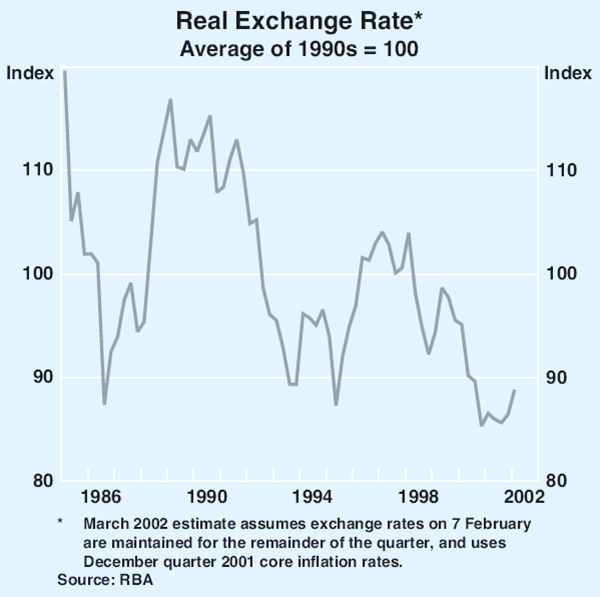
Inflation Trends and Prospects
Recent developments in inflation
Consumer prices
The Consumer Price Index (CPI) increased by 0.9 per cent in the December quarter, after rising by 0.3 per cent in the September quarter, to be 3.1 per cent higher over 2001 (Graph 65). The increase in the quarter reflected sharp rises in the prices of some food items and the cost of airline travel which were partly offset by a further fall in petrol prices.
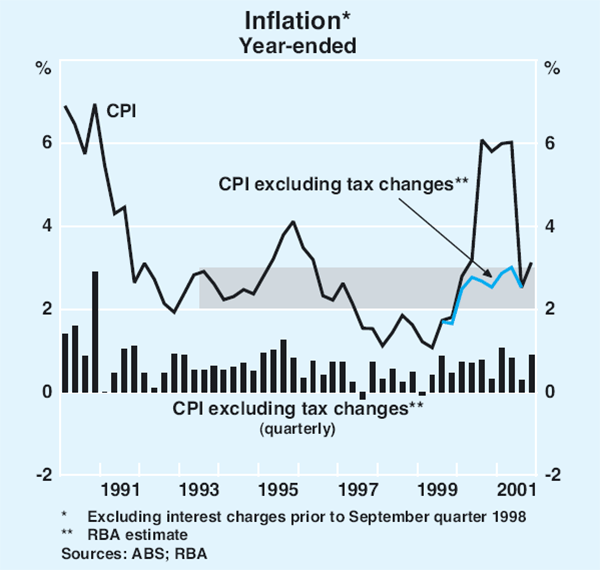
Measures of underlying inflation are providing different estimates of the rate of core inflation. Measures that use statistical criteria, such as the weighted median and trimmed mean, suggest core inflation was around 0.7 per cent in the December quarter and around 3¼ per cent over the year (Table 17). Other measures which are based on the exclusion of a fixed basket of items, such as market sector goods and services excluding volatile items, increased by around 1 per cent in the quarter and by 3.6 per cent over the year. The differences reflect the differing approaches to constructing these underlying measures: the fixed-basket measures include those factors that on this occasion are adding to inflation (meat and air travel), while removing the main negative influence (petrol), resulting in a relatively high figure. On balance, the statistical measures are probably providing a more reliable indication of underlying inflation at present.
| Quarterly | Year-ended | ||||
|---|---|---|---|---|---|
| September quarter 2001 |
December quarter 2001 |
September quarter 2001 |
December quarter 2001 |
||
| CPI | 0.3 | 0.9 | 2.5 | 3.1 | |
| – Tradables | −0.6 | 0.8 | 2.5 | 3.1 | |
| – Non-tradables | 1.1 | 1.0 | 2.6 | 3.1 | |
| Underlying inflation | |||||
| Weighted median(a) | 0.7 | 0.7 | 3.0 | 3.2 | |
| Trimmed mean(a) | 0.7 | 0.7 | 2.9 | 3.3 | |
| CPI excluding volatile items | 0.7 | 0.9 | 2.9 | 3.6 | |
| Market goods and services excluding volatile items |
0.7 | 1.1 | 2.8 | 3.6 | |
|
(a) For details on the calculation of these measures, see ‘Measuring Underlying Inflation’, RBA Bulletin, August 1994, available at <www.rba.gov.au/publicationsandresearch/bulletin/#1994>. Sources: ABS; RBA |
|||||
Although higher prices were recorded for almost all food categories, sharp increases in the prices of some fruit and vegetables made the largest contributions, reflecting weather-and disease-related supply problems. Meat prices again rose sharply, boosted by strong world demand for Australian meat products. Higher dairy prices also reflected strong world demand as well as a partial unwinding of earlier price falls associated with the restructuring of the industry. Excluding food, the CPI rose by 0.5 per cent in the December quarter and by 2.2 per cent over the year.
Domestic holiday travel and accommodation prices increased by 7.7 per cent in the December quarter, but were flat over the year. The rise in the quarter reflected a seasonal rise in price as well as recent developments in the airline industry, including the introduction of the Ansett and insurance airfare levies. These developments are likely to have some further effect in the March quarter. The cost of house purchase again rose by around 1 per cent in the December quarter, consistent with the recovery of the housing market. Other significant price increases were recorded for some items of women's clothing and telecommunications. Despite recording a slight fall in the quarter, insurance costs rose by 6 per cent over 2001 (see Box C).
The most substantial offset to the general increase in prices in the December quarter was a 3.7 per cent fall in petrol prices, which brought the fall over 2001 to 12 per cent. Audio, visual and computing equipment prices also continued to fall in the quarter while lower health costs mostly reflected the seasonal effect of the Pharmaceutical Benefits Scheme.
Both tradables and non-tradables prices increased by 3.1 per cent over the year to the December quarter. Excluding petrol and food, tradables prices have been growing at a faster pace, rising by 3½ per cent over 2001 (Graph 66). This may reflect continued pass-through of the earlier exchange rate decline and may persist for a while yet, although the exchange rate has been relatively stable over the past year.
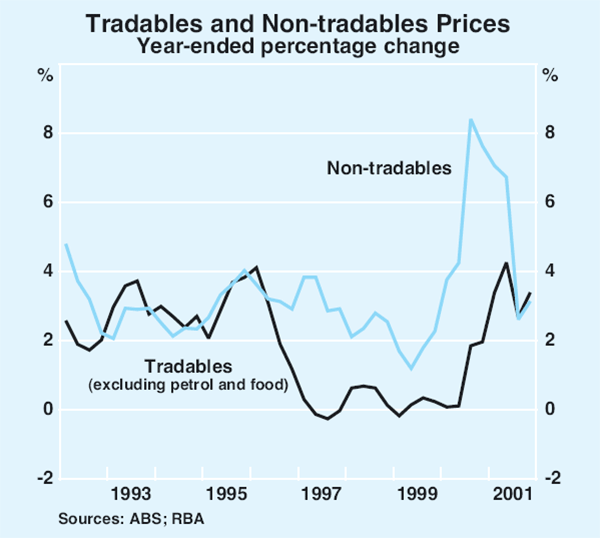
Producer prices
Input cost pressures continued to moderate over the course of 2001. Over the year to December, producer prices at all stages increased by less than 2 per cent, down from rates of over 5 per cent a year earlier (Table 18). A significant cause of the moderation has been falling oil prices, with the Asian benchmark oil price declining by 20 per cent in the December quarter following a 10 per cent fall in September.
| Dec qtr 2001 |
Year to Dec qtr 2000 |
Year to Dec qtr 2001 |
|
|---|---|---|---|
| Preliminary | −0.4 | 10.2 | −0.4 |
| – Domestic | −0.3 | 7.5 | 0.8 |
| – Imported | −1.7 | 27.1 | −6.9 |
| Intermediate | 0.1 | 8.4 | 1.0 |
| – Domestic | 0.3 | 6.4 | 2.0 |
| – Imported | −0.7 | 21.8 | −4.8 |
| Final(a) | |||
| Domestic | 0.4 | 4.1 | 1.8 |
| – Consumption | 0.2 | 4.0 | 2.0 |
| – Capital | 0.5 | 4.0 | 1.7 |
| Imported | 1.3 | 10.6 | 1.0 |
| – Consumption | 1.3 | 11.3 | 1.7 |
| – Capital | 1.5 | 9.9 | 0.3 |
| Total | 0.6 | 5.2 | 1.7 |
| – Excluding oil | 0.8 | 3.9 | 2.7 |
| – Consumption | 0.5 | 5.4 | 1.9 |
| – Capital | 0.7 | 5.1 | 1.4 |
|
(a) Excluding exports Source: ABS |
|||
In contrast to the September quarter, import prices generally increased, apart from oil and computer equipment prices, with strong growth recorded in the prices of industrial machinery and motor vehicles. On an industry basis, producer price inflation remains moderate with a few exceptions, such as real estate agent services, which have risen by 10 per cent over 2001. There was also an increase in building construction prices, consistent with the upturn in activity in the construction sector. The prices of materials used in manufacturing fell by 1.9 per cent in December, whereas the prices of articles produced fell by 0.6 per cent.
Recent business surveys also suggest that upstream inflationary pressures have continued to moderate, and that growth in final prices is expected to remain low as a result. The economy-wide NAB survey reports that purchase costs increased by only 0.4 per cent in the December quarter and that firms expect costs to increase by an average of just ¼ per cent in the March quarter (Graph 67). The latest ACCI-Westpac survey reported a further easing in inflationary pressures in the manufacturing sector. The net balance of firms expecting cost increases fell further in the December quarter.
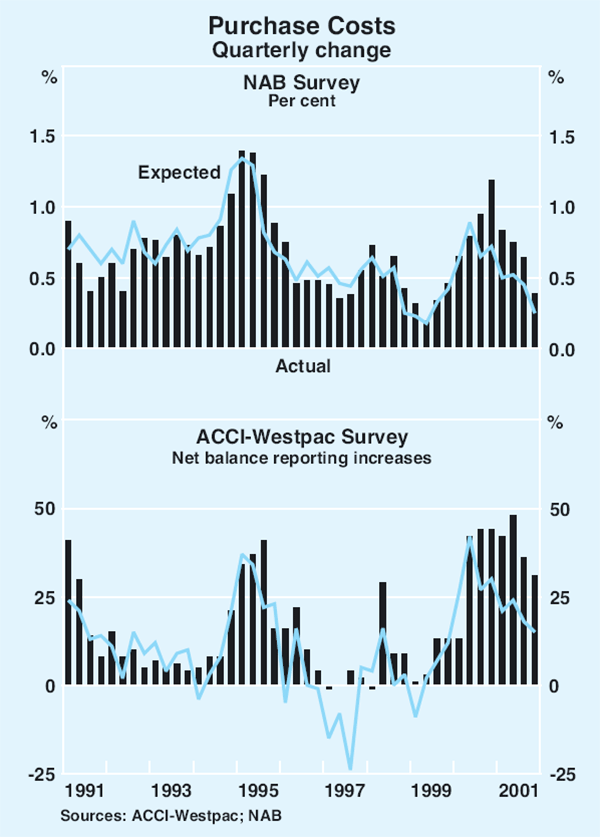
Labour costs
Wage pressures remain well contained, reflecting the subdued conditions in the labour market (Graph 68). Growth in the Wage Cost Index (WCI) for total pay eased slightly in the September quarter to 3.6 per cent over the year, after having drifted up over the previous eighteen months. By industry, among the fastest rises in wages continued to be in property and business services and education, which both increased by 4.4 per cent over the year, while the retail sector again recorded the slowest growth, at 2.3 per cent. Data on enterprise bargaining agreements also indicate modest wage pressures. New federal enterprise agreements ratified in the September quarter provided an average annualised wage increase of 3.9 per cent, the same as in the previous quarter. Measures of unit labour costs have also eased in recent quarters to be growing at a rate of around 1¾ per cent over the year to September.
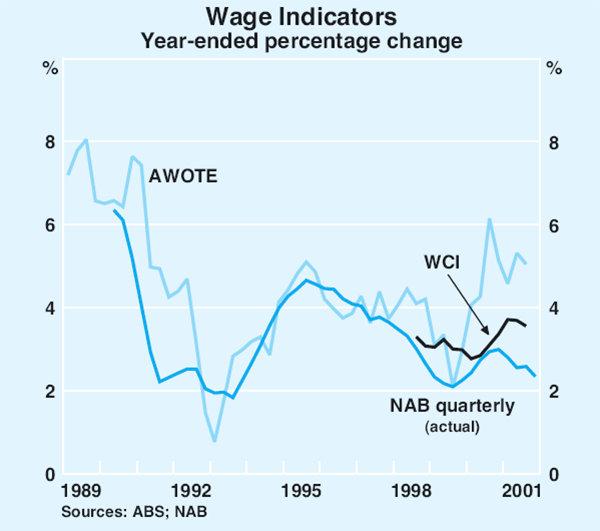
The average weekly earnings survey continues to be affected by compositional changes, which reduce its usefulness as an indicator of wages growth. The past couple of quarters have also been affected by a higher-than-usual sample rotation. Average weekly ordinary-time earnings of full-time adults (AWOTE) rose by 1.4 per cent in the September quarter to be 5 per cent higher than a year ago, down from 5.3 per cent in the June quarter.
According to the latest Mercer Cullen Egan Dell Quarterly Salary Review, the average annual wage increase for office workers edged up to 4½ per cent in the December quarter. The base salary of executives rose by 5 per cent over the course of 2001, up slightly from the pace of around 4¾ per cent reported in the previous couple of quarters. Recent business surveys also report that wage pressures remain in check, with the latest quarterly NAB survey reporting modest growth in labour costs in the December quarter and firms expecting this to continue in the March quarter. Firms report little difficulty attracting suitable labour, consistent with the relatively low levels of the major job vacancy series.
The Australian Industrial Relations Commission (AIRC) is expected to decide on the 2002 Safety Net Review of award wages in May. It is considering an application by the Australian Council of Trade Unions (ACTU) to increase all award rates of pay by $25 per week.
Inflation expectations
The inflation expectations of consumers have remained in a range between 3½ and 4½ per cent since mid 2000 (Graph 69). The Melbourne Institute survey reported that consumers' expectations for inflation over the coming year rose to 4.5 per cent in January from around 3½ per cent in November and December. Recent business surveys indicate that businesses have continued to moderate their expectations for inflation. The economy-wide NAB survey reported that inflation in final product prices and retail prices was expected to be 0.3 per cent in the March quarter. The NAB survey also indicated that medium-term inflation expectations of businesses fell in the December quarter. A little less than 10 per cent of businesses expect inflation to average more than 4 per cent in the medium term (compared with around 30 per cent in the mid 1990s), while almost 40 per cent of respondents expect inflation to average less than 3 per cent (compared with around 10 per cent in the mid 1990s). The latest ACCI-Westpac survey reported an easing in inflation expectations in the manufacturing sector for the March quarter.
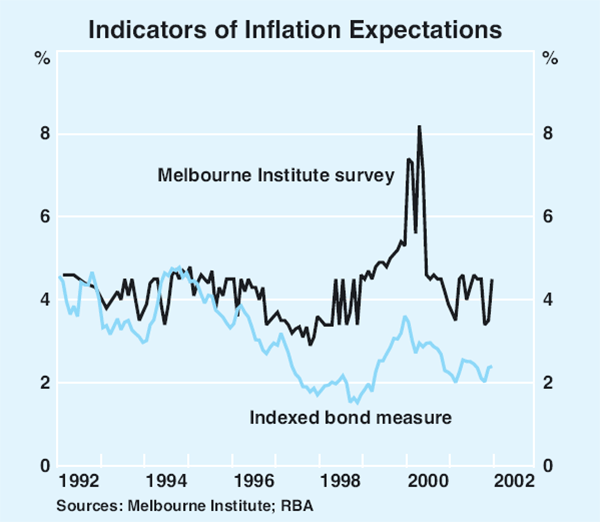
In contrast, longer-term inflation expectations of investors, measured by the difference between 10-year bond yields and indexed bonds, have moved higher in recent months to average between 2¼ and 2½ per cent in December and January. Similarly, most financial-market economists surveyed by the Bank have made upward revisions to their forecasts for inflation following the release of the December quarter CPI (Table 19). The median inflation forecasts for the years to June 2002 and June 2003 have both increased to 2.4 per cent. Trade union officials surveyed by the Australian Centre for Industrial Relations Research and Training (ACIRRT) have also revised up their expectations for inflation.
| Year to June 2002 | Year to June 2003 | ||||||
|---|---|---|---|---|---|---|---|
| August 2001 |
November 2001 |
February 2002 |
August 2001 |
November 2001 |
February 2002 |
||
| Market economists(a) | 2.3 | 2.0 | 2.4 | 2.5 | 2.2 | 2.4 | |
| Union officials(a) | 4.0 | 2.9 | 3.3 | 3.8 | 3.1 | 3.9 | |
| (a) RBA survey (b) ACIRRT survey |
|||||||
Inflation outlook
The various measures of underlying inflation give a range of readings for core inflation in the December quarter but, as discussed above, the Bank's assessment is that underlying inflation was around 3¼ per cent over the year to December, continuing the gradual upward trend in underlying inflation evident since 1999. This is in line with the forecasts presented in previous Statements, which indicated that underlying inflation would exceed the target for a short period.
Some of the sharp price rises that underpinned the December quarter outcome are likely to be temporary. Half of the increase in the CPI in the quarter was due to food, and it is probable some of these increases, in particular for fruit and vegetables, will be partly reversed over coming quarters. The prices for other items, such as meat and dairy products, may remain high in the near term, but should not continue rising at their current pace. Domestic travel and accommodation prices increased significantly in the quarter, consistent with previous seasonal patterns, but also reflected recent developments in the airline industry that are likely to provide a further boost to prices in the March quarter. The price increases for some categories of clothing and furniture follow a period of extensive discounting and may continue in the next few quarters as retailers seek to rebuild margins. The increase in house purchase costs could also persist for the next few quarters until activity in the housing sector slows. Thus while some of the sector-specific price pressures evident in the December quarter should dissipate, others may persist for another quarter or so.
However, the outlook for the medium-term determinants of inflation has not changed substantively in light of the recent data. Wage and labour cost growth remain contained and are likely to continue to be so given the prevailing weakness in the labour market. The stability of the exchange rate over the past year, combined with downward pressure on world prices from the subdued global economy, suggests that there will be little inflationary pressure from import prices in the medium term. Producer price data and business surveys suggest that upstream price pressures have continued to ease, underpinned by the decline in oil prices.
Given that the medium-term influences on inflation remain broadly unchanged, the Bank's assessment continues to be that underlying inflation is at or near its peak and will decline to around 2½ per cent through 2002. CPI inflation should remain close to the underlying measures. This is based on the assumption that the exchange rate remains at recent levels, and that oil prices drift moderately higher over the coming year.
The November Statement considered that the risks to the central forecasts were slightly weighted to the downside. The recent data suggest that upside risks to the outlook for inflation have subsequently increased, particularly in the near term. The current strength of the economy may result in more margin building in the quarters ahead than is currently allowed for. This would maintain the inflation rate at or near the top of the target and could lead to an upward shift in inflation expectations. In these circumstances, if the domestic economy were to gather strength, there would be a risk of inflation remaining above the target for a longer period.
At the same time, the downside risks to the inflation outlook identified in the November Statement remain. If the downturn in the global economy is more protracted than expected, there would be further downward pressure on international prices, in particular oil prices. This would contribute to slower than anticipated growth in the Australian economy and a more prolonged period of weakness in the labour market, further restraining wage and price increases. At present, the Bank considers these risks to the inflation outlook to be more evenly balanced.
Box C: Insurance Prices
The price of insurance has risen markedly over the past year and further price rises are likely in the period ahead. This follows substantial losses in the global insurance industry in recent years, an escalating assessment of future insurance payouts, the collapse of HIH and lower returns on the assets held by insurance companies.
The rise in reinsurance premiums following large losses due to natural and man-made catastrophes is one of the main reasons for an increase in costs to the Australian insurance industry (Graph C1). In 1999, there were an unusual number of large natural catastrophes around the world, including the Sydney hailstorm that was the eighth largest insured loss in the world in that year. The insured loss from the events of 11 September is likely to exceed the largest preceding single-event loss, Hurricane Andrew in 1992, when the insurance industry paid claims of roughly US$20 billion (in 2001 prices).
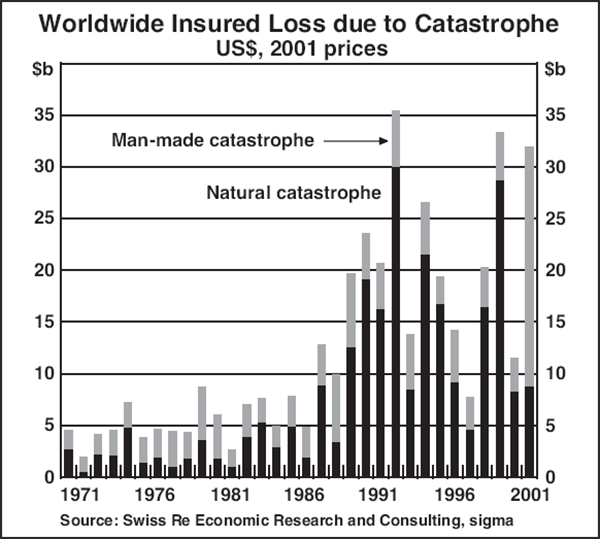
As a consequence of these large losses, reinsurers' capital reserves have declined, and this has led to a contraction in the supply of reinsurance. In combination with an increase in demand for reinsurance, this has resulted in a sharp increase in price. In addition to this, a more long-lasting effect on insurance premiums from recent events will depend upon the extent to which the risk of both natural and man-made catastrophes is reassessed. A further reason why costs faced by the Australian insurance industry have increased is that the Australian community is becoming more willing to claim for losses incurred. This has led to an increase in the actuarial assessment of expected payouts, particularly for products such as public liability insurance.
As well as changes in costs, insurance premiums are influenced by the degree of competition in the insurance market. In recent years the Australian general insurance industry has been characterised by strong competition which has held down direct insurance premiums despite the rising costs. An important factor behind this was HIH's policy of aggressively building market share by offering lower premiums. With this effect no longer operating, a return to more normal practices would see some rise in premiums.
Effects on the CPI
Insurance premiums affect the CPI directly through households' purchases of car, house and contents insurance which has a weight of 1.5 per cent in the CPI. The price of household insurance services in the CPI has increased by 6 per cent over the past year. However, there is also an indirect effect as rising commercial premiums for businesses are passed through to consumer prices.
Insurance industry surveys, such as the JP Morgan-Trowbridge Consulting-Deloitte survey, suggest that even prior to the events of September, industry observers were expecting some classes of commercial insurance premiums to rise by up to 20 per cent over the year to June 2002. The largest increases are expected for professional indemnity, public liability and commercial property insurance, as these areas are most affected by the problem of higher numbers of claims and higher reinsurance costs. More recently, the cost of products such as airline liability insurance have increased and have been passed on quickly to consumers.
Footnote
In terms of impact on the exchange rate, Uridashi issuance may be more significant than ‘headline’ dual currency issuance. For a new Uridashi issue, the impact on the A$ is equal to the full principal of the bond at the time of purchase. However, Australian dollar flows associated with a dual currency issue are less than the bond's full face value, because not all of the associated cash flows are in A$. [1]